This post may contain affiliate links which may generate a small commission from clicks that result in a purchase.
Olive trees have become increasingly popular for container gardening thanks to their stunning appearance, adaptability, and delicious olives they produce. But, as with any plant, there might be a few problems with olive trees in pots I would like to speak about today.
I’ll discuss common challenges, such as insufficient light, temperature extremes, watering issues, nutrient deficiencies, environmental stress, etc. As well as I will offer practical solutions to help your potted olive tree thrive.
By knowing how to reduce the source of stress and solve these problems, growing olives will become easier and more fun! Whether you’re a seasoned gardener or just starting, let’s learn the most common issues you want to avoid when caring for olive trees in pots.
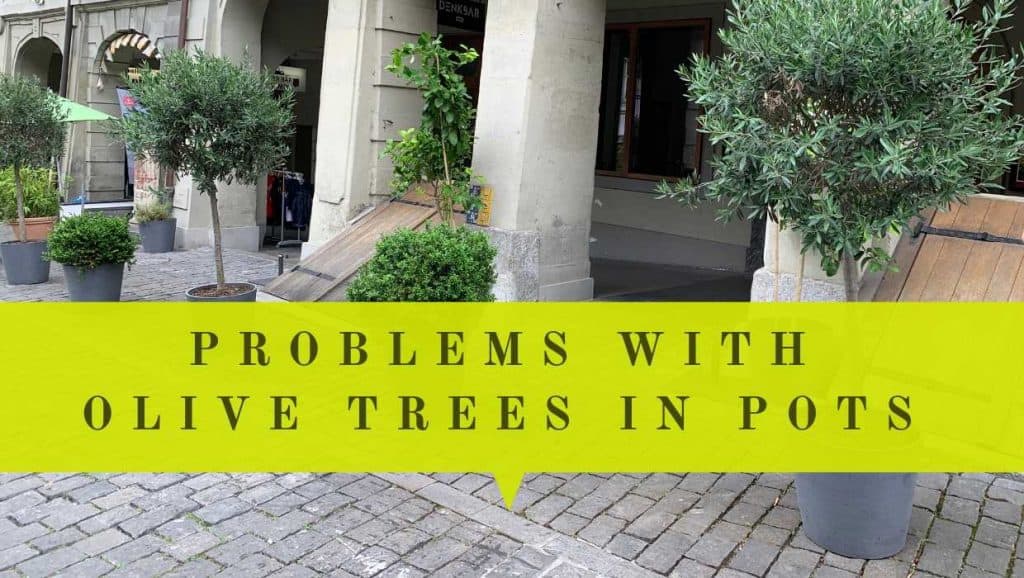
I. Watering Problems
Watering problems, such as overwatering or underwatering, are common challenges faced by potted olive tree growers, and finding the right balance is crucial for maintaining a healthy plant.
1. Over-watering
Olive tree watering is probably one of the trickiest things to get right, as many variables can affect it. For example, the soil, sun, olive cultivar, and climate all influence how much (or little) you need to water your olive trees. Watering issues can easily stress olive trees and lead to dropping leaves, flowers, and olive fruits.
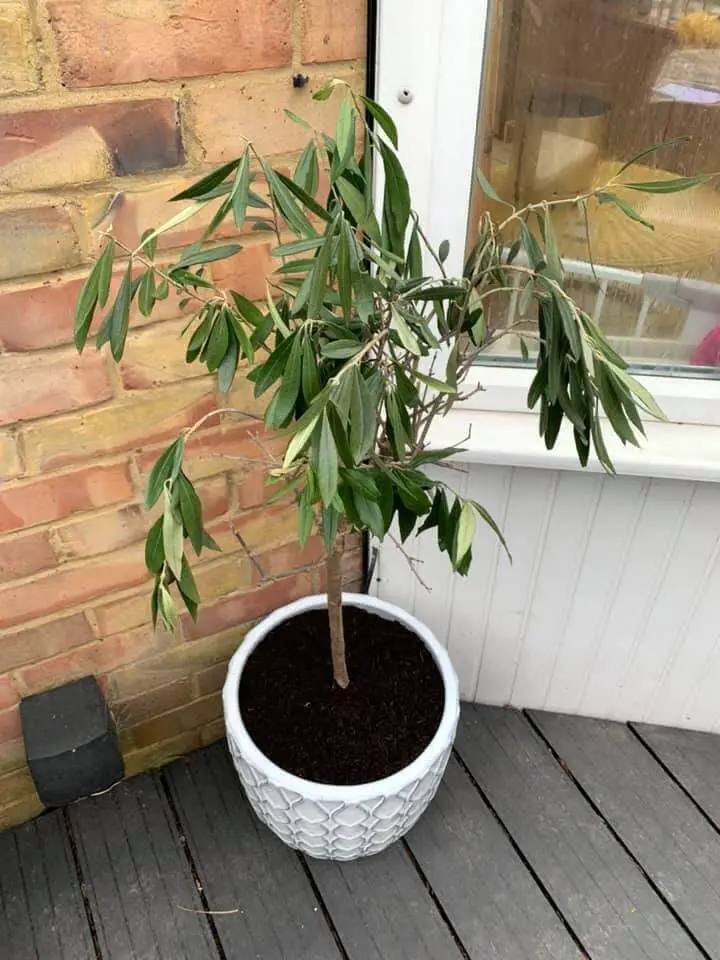
Over-watering is the most common cause of olive trees’ poor health, leading to root rot and fungal diseases. Generally, an olive tree hates having wet roots, and the real problem with olive trees in pots is sitting in the wet soil.
Symptoms
- Soil stays moist every day: Consistently damp soil is a clear indicator of overwatering.
- Water stays standing in the dish: If water remains in the saucer beneath your pot, it indicates excessive watering.
- Wet pot: The bottom of a pot should not be consistently damp or discolored.
- Root rot: The roots may become dark, slimy, and emit a foul smell due to excess moisture.
- Fungus gnats: If you notice little bugs like fruit flies around your tree, it could indicate that your pot stayed moist for too long.
- Mold or fungus: Excessive moisture can create a breeding ground for mold and fungal infections.
- Drooping, but not dry leaves: Overwatered olive trees may have drooping leaves that aren’t dry or crisp.
- Soft, mushy leaves: Overwatered olive trees may have leaves that feel soft and mushy to the touch.
- Gradual yellowing and leaf drop: Overwatering may be the culprit if leaves turn yellow all over and then drop, especially the lower ones.
- Flower and fruit drop: Overwatering can cause olive tree flowers and fruits to drop prematurely.
Solutions
Now that you know the signs of overwatering, let’s dive into some expert tips to keep your potted olive tree perfectly hydrated.
Check the Soil
The risk of over-watering will be significantly reduced by checking the soil way before watering. Do water deeply, but only water again when the olive tree pot is nearly dry.
You can also use your touch and feel senses – the top inch or two (i.e., 2.5 – 5 cm) of soil transition from dark and moist to the touch to lighter and dry. Then, time to water. If it’s still moist, wait a day or two before checking again.
Buy a moisture meter to help remove some stressful guesswork from watering olive trees. Insert it fully into the soil. In larger pots, taking two to three readings in different spots is helpful.
Last update on 2024-04-18 / Affiliate links / Images from Amazon Product Advertising API
Drainage is Key
Ensure your pot has sufficient drainage holes to prevent standing water, which can lead to root rot. If your olive tree pot doesn’t have or lacks drainage holes, make them yourself.
For instance, the self-watering pot puts soil inside hollow legs that reach into the water. As a result, it draws moisture naturally without wicks. Simultaneously it lifts your plant above standing water. It also keeps the plant’s delicate root system from being constantly flooded. This great invention eliminates common problems associated with olive tree overwatering symptoms and mold and fungus.
Watering Routine
Once re-potted in well-draining soil, make sure to water your olive tree every day to establish roots. Afterward, water your olive tree in the pot 1-2 times per week, depending on overall environmental conditions (see the table below).
This table shows your olive tree’s watering routine and quantity depending on factors such as pot size, local climate conditions, and individual tree needs. Always check the soil moisture before watering and adjust the frequency and water quantity as needed to ensure the health and well-being of your olive tree.
| Season | Temperature (°F/°C) | Tree Size | Watering Frequency | Water Quantity (gal/L) |
|---|---|---|---|---|
| Spring | 60-70°F / 16-21°C | Small (Up to 36 in / 0.9 m) | Every 7-10 days | 0.5-1 gal / 2-4 L |
| Spring | 60-70°F / 16-21°C | Medium/Large (Over 36 in / 0.9 m) | Every 5-7 days | 1-2 gal / 4-8 L |
| Summer | 75-95°F / 24-35°C | Small (Up to 36 in / 0.9 m) | Every 3-5 days | 0.5-1 gal / 2-4 L |
| Summer | 75-95°F / 24-35°C | Medium/Large (Over 36 in / 0.9 m) | Every 2-4 days | 1-3 gal / 4-12 L |
| Fall | 55-65°F / 13-18°C | Small (Up to 36 in / 0.9 m) | Every 7-10 days | 0.5-1 gal / 2-4 L |
| Fall | 55-65°F / 13-18°C | Medium/Large (Over 36 in / 0.9 m) | Every 5-7 days | 1-2 gal / 4-8 L |
| Winter (Indoor) | 65-75°F / 18-24°C | Small (Up to 36 in / 0.9 m) | Every 10-14 days | 0.5-1 gal / 2-4 L |
| Winter (Indoor) | 65-75°F / 18-24°C | Medium/Large (Over 36 in / 0.9 m) | Every 7-10 days | 1-1.5 gal / 4-6 L |
| Winter (Outdoor) | 32-50°F / 0-10°C | Small (Up to 36 in / 0.9 m) | Every 14-21 days | 0.5-1 gal / 2-4 L |
| Winter (Outdoor) | 32-50°F / 0-10°C | Medium/Large (Over 36 in / 0.9 m) | Every 10-14 days | 1-2 gal / 4-8 L |
Tree sizes in the table explained here:
- Small: Up to 3 feet tall (approx. 36 inches or 0.9 meters)
- Medium: Between 3 and 6 feet tall (approx. 36-72 inches or 0.9-1.8 meters)
- Large: Over 6 feet tall (more than 72 inches or 1.8 meters)
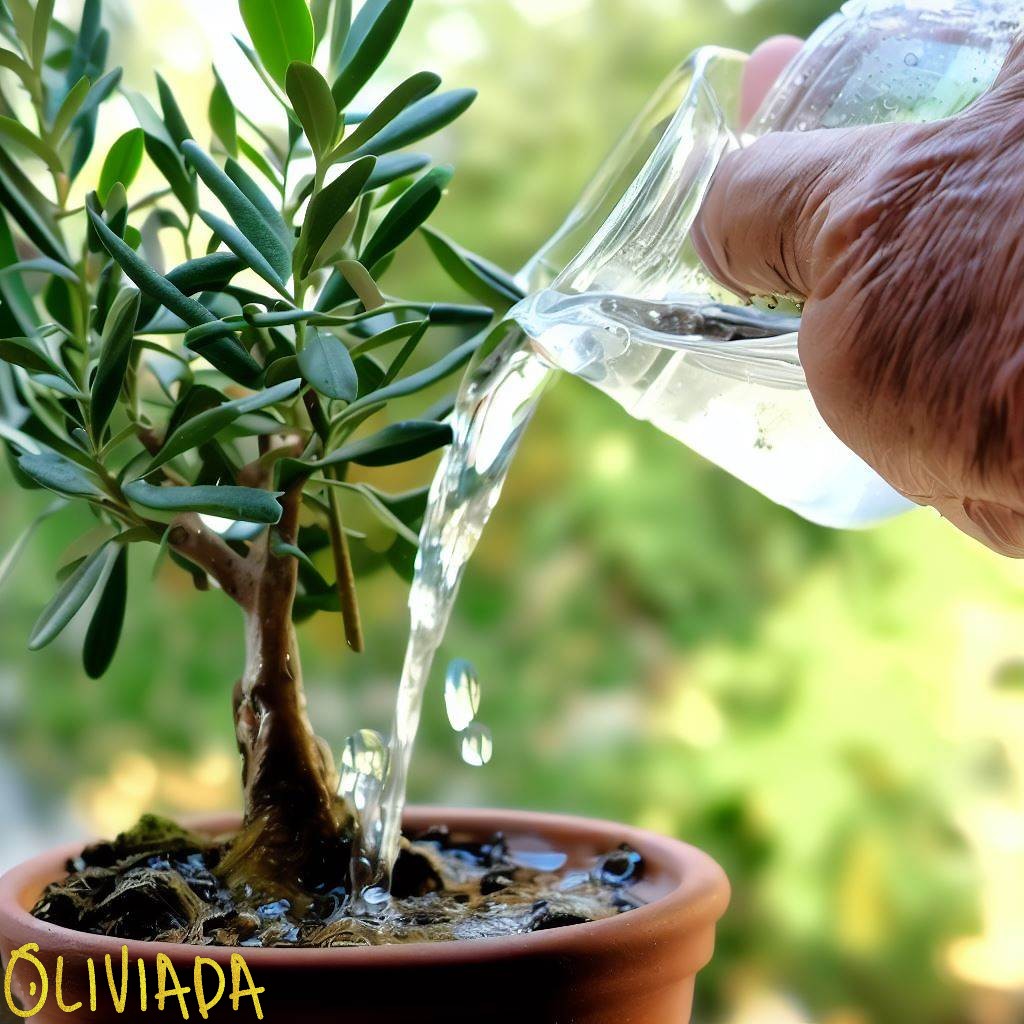
Watering Routine Optimisation
- Seasonal adjustments: The watering needs of your olive tree will vary depending on the season. During the warmer months, your tree will require more frequent watering; you can reduce the frequency in the cooler months. Keep an eye on the soil moisture and adjust your watering routine accordingly.
- Weather considerations: Pay close attention to changes in the weather. If you’re experiencing extreme heat, you might need to water your tree more often to prevent it from drying out. On the other hand, if there’s been an extended period of rain, reduce watering to avoid overwatering your tree.
- Soil type: Different potting soils have varying water retention capabilities. Some soils, such as those with a high percentage of peat or coconut coir, can retain water for longer periods, reducing the need for frequent watering. On the other hand, sandy or well-draining soils might require more frequent watering to maintain adequate moisture levels.
- Water quality: When watering your olive tree, use high-quality water to ensure the tree’s health. Avoid using saltwater or heavily chlorinated water, as they can cause damage to the tree’s roots and overall health. If tap water is heavily chlorinated, consider using filtered or rainwater instead.
- Drought-tolerant varieties: Some olive tree varieties are more drought-tolerant than others, meaning they can survive with less frequent watering. If you live in an area with water restrictions or want to reduce water usage, consider planting drought-tolerant varieties like Arbequina or Koroneiki.
- Signs of underwatering and overwatering: Recognize the signs of underwatering and overwatering to adjust your watering routine accordingly. Underwatered trees may exhibit wilted leaves, leaf drops, and stunted growth. Overwatered trees can also experience leaf drop, yellowing leaves and root rot. Adjust your watering routine based on these signs to keep your tree healthy.
Considering these factors, you can create an optimal watering routine for your potted olive tree, ensuring it stays healthy and productive throughout the year.
Relevant articles
- Olive tree overwatering symptoms
- How often to water olive trees indoors and how much
- How to use a moisture meter for olive trees
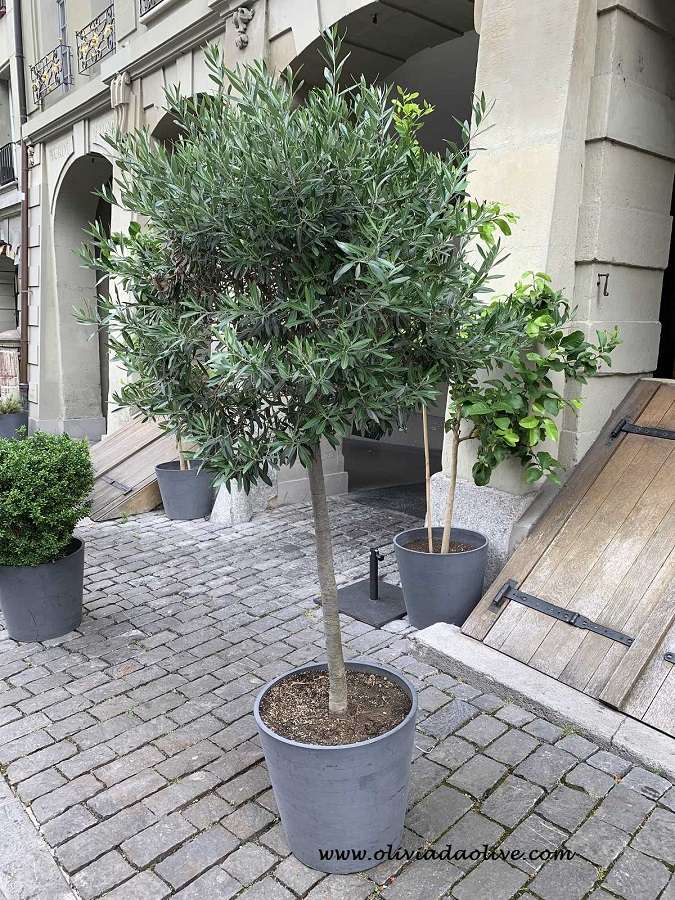
2. Under-watering
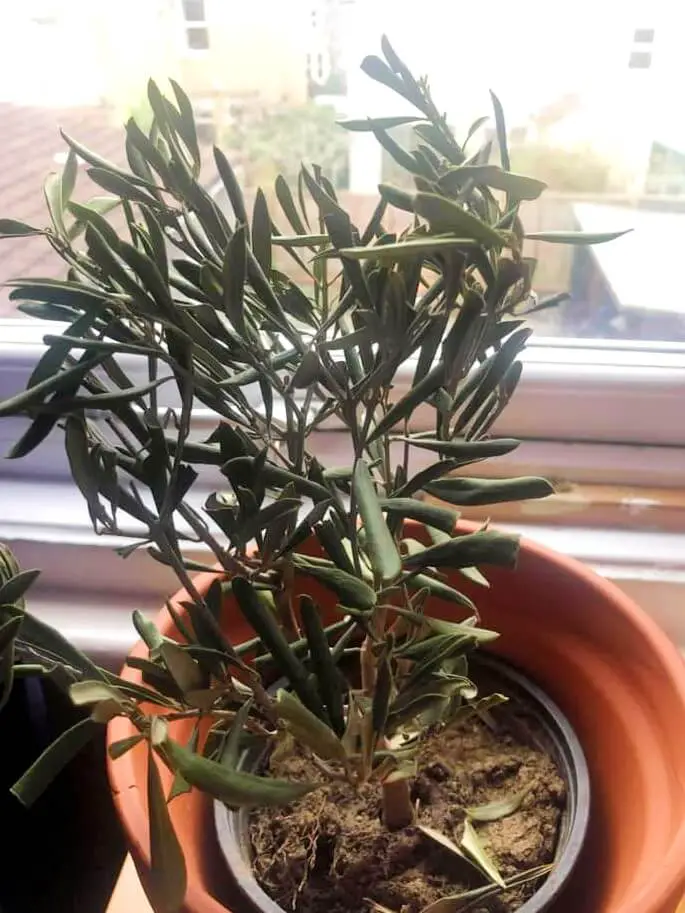
While avoiding overwatering is essential, ensuring our potted olive trees receive enough hydration to thrive is equally crucial. The potted olive tree will dry out far more quickly than those growing in the ground and need regular watering. Potted olive trees quickly struggle to survive if tree roots are not kept moist. Let’s dive into the signs of underwatering and how to remedy it.
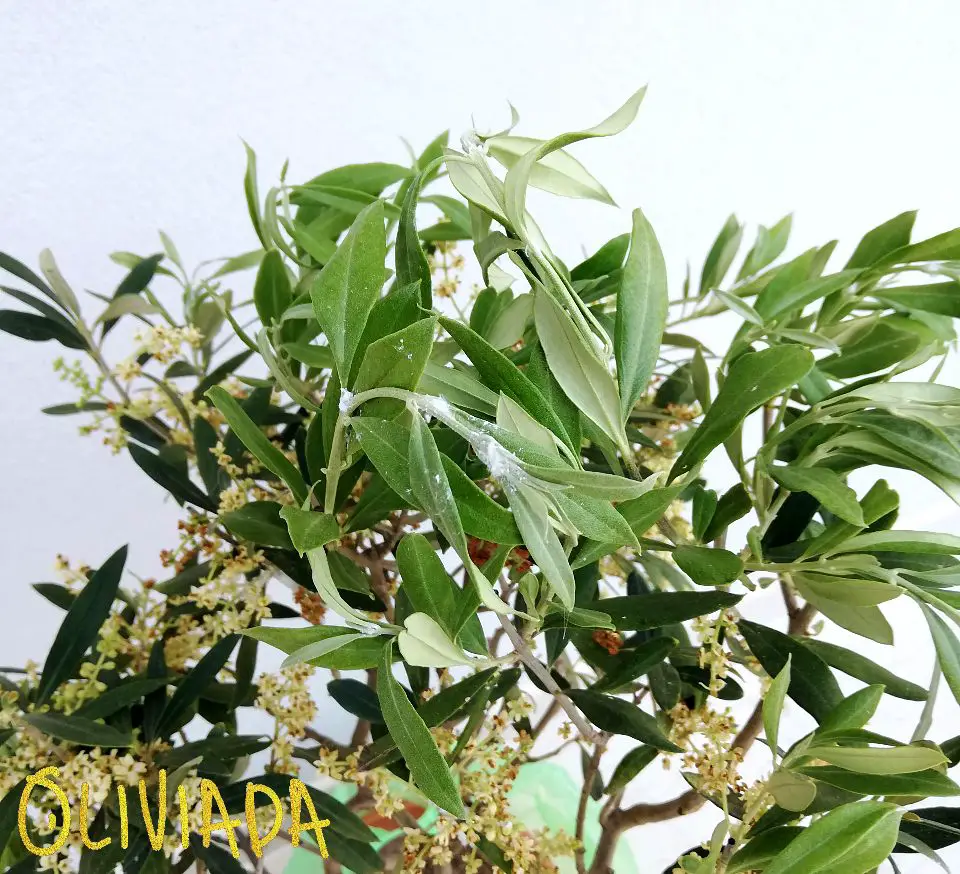
Symptoms
- Soil pulls away from the sides of the pot: When the soil is too dry, it may shrink and pull away from the pot’s edges.
- Water sits on top of the soil: If water takes a while to drain and sits on the soil surface, it could indicate underwatering.
- Water runs quickly through the pot: When the soil is too dry, water might pass through too quickly without being properly absorbed.
- Slow growth: A lack of water may stunt the growth of your olive tree as it struggles to obtain the necessary nutrients.
- Leaves wilting and drooping: A consistently wilted olive tree, even after watering, is a sign that it needs more hydration.
- Yellow or brown leaves: Dry, brittle leaves, especially near the bottom of the tree, may indicate underwatering.
- Crisp leaves and dying branches: Olive tree leaves may droop and turn crisp, and branches could die due to insufficient water.
- Leaf drop: Underwatering can cause leaves to drop prematurely from the tree.
- Flower and fruit drop: Insufficient water can lead to dropping flowers and fruits before they have a chance to fully develop.
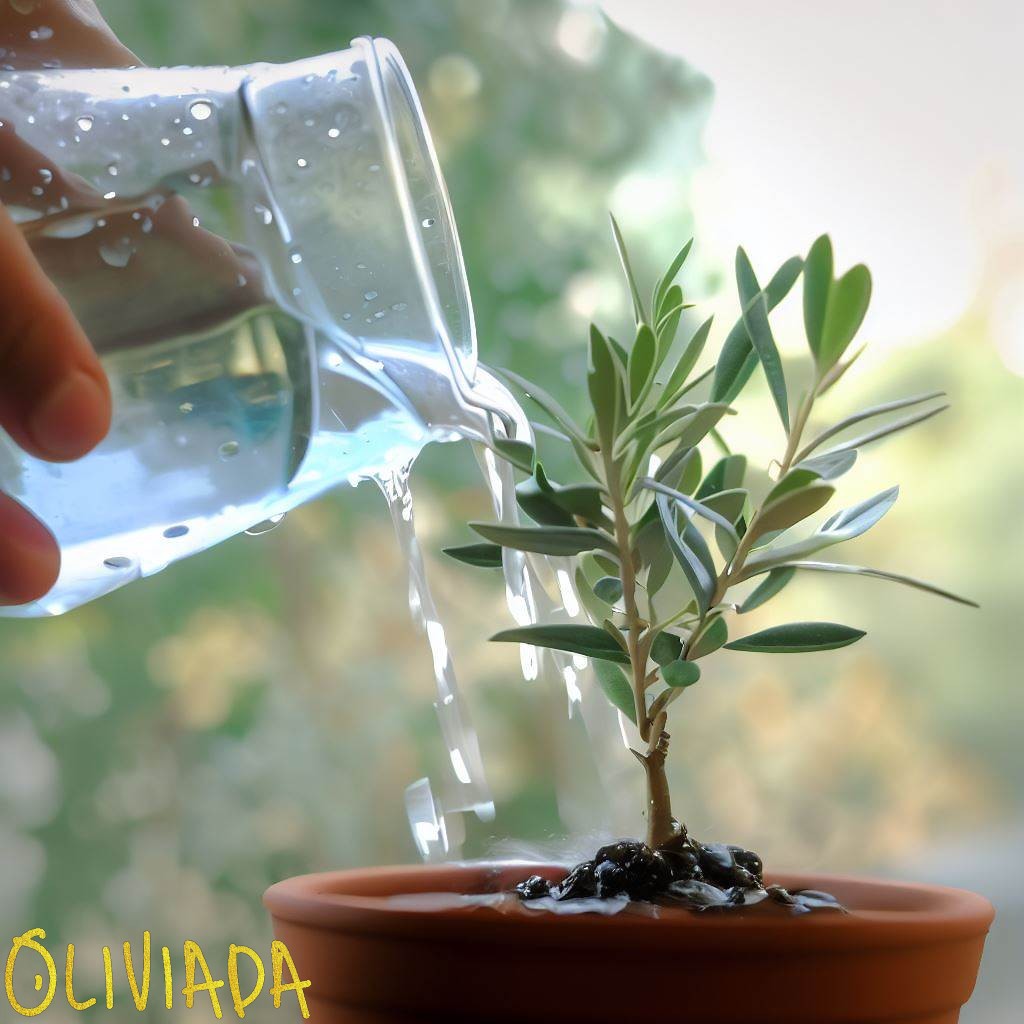
Solutions
Let’s explore some ways to ensure your olive tree gets the right amount of water:
Check Soil Moisture
Before watering, check the soil moisture by sticking your finger about 1-2 inches (approx 5 cm ) deep into the soil. If it feels dry, it’s time to water. Or use the moisture meter discussed above.
Adjust Watering Frequency
Increase the watering frequency, especially during hotter months or when the tree grows. Refer to the watering chart shared previously for guidance.
Water Deeply
When watering your olive tree, make sure to give it a thorough soak, allowing the water to penetrate deep into the root system. This encourages the roots to grow downwards and strengthens the tree.
Mulch
Adding a layer of mulch around the base of your olive tree can help retain moisture in the soil, reducing the risk of underwatering.
Relevant articles
To simplify regular olive tree care, we have prepared a complete guide on water requirements for olive trees in pots to learn how to avoid overwatering or underwatering issues.
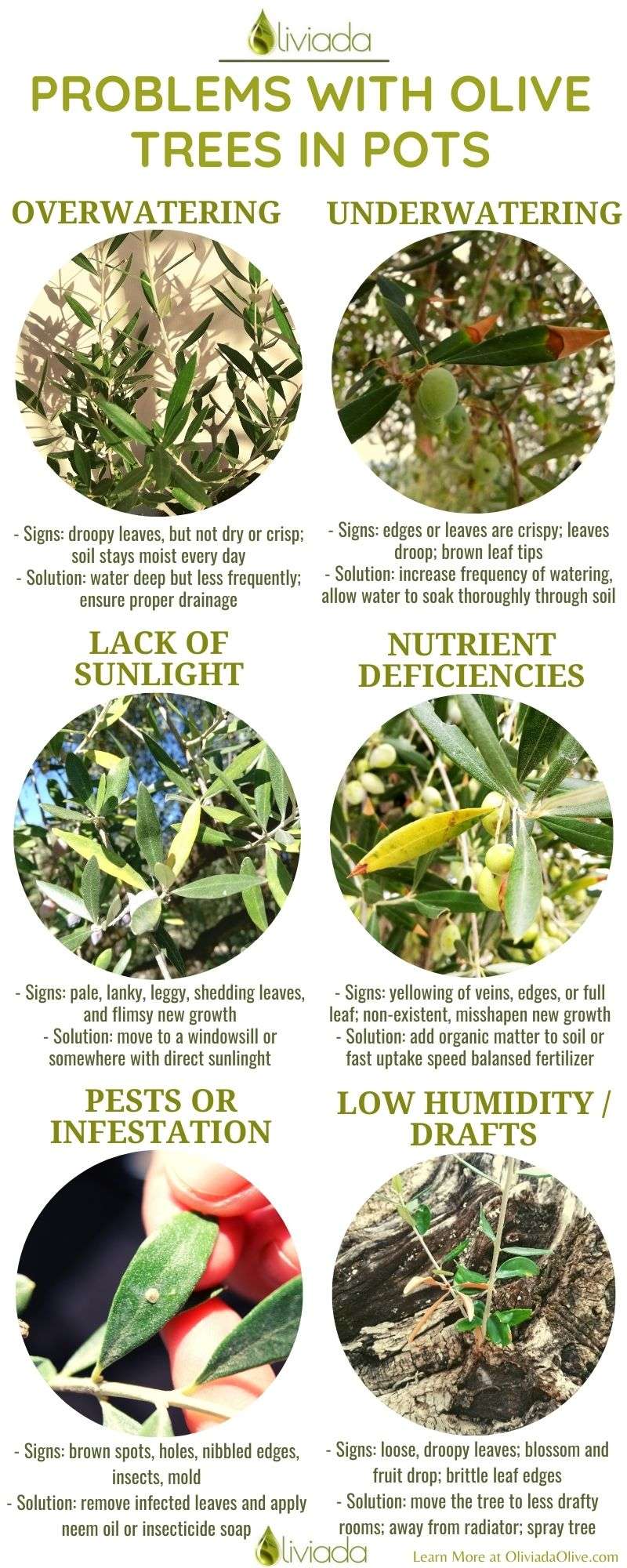
II. Soil Problems:
1. Poor Drainage
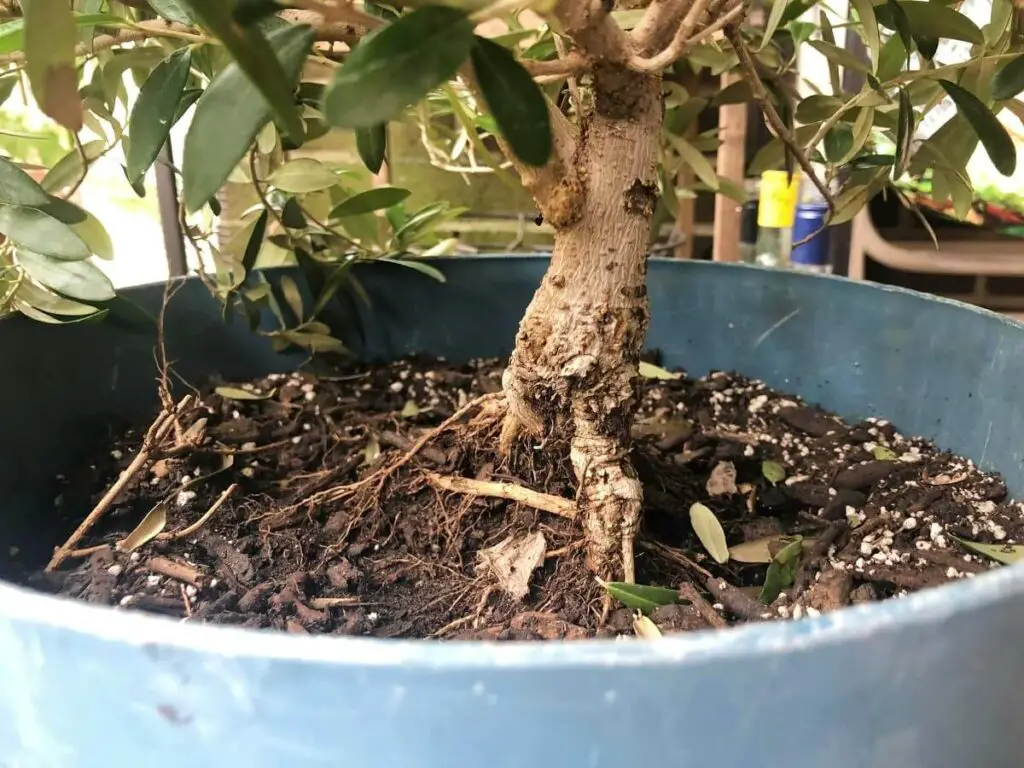
In general, an olive tree requires outstanding drainage. No doubt, soggy bottoms can kill the olive tree. Even if you have the correct pot size for your olive tree, you can run into root rot and other problems if there are not enough drainage holes. To avoid it, you must find an adequate pot with drainage holes where water flows through the pot and out.
Well-drained soil is also essential. Use an indoor potting mix containing coconut coir which holds and releases water and helps soil quickly rewet. Better yet, buy premixed organic potting soil formulated specifically for olive trees with adjusted acidity (= pH 6 – 7).
Symptoms
- Waterlogged soil: If the soil remains wet and soggy for extended periods, your tree’s drainage might be insufficient.
- Standing water: Water collecting at the bottom of the pot or in the saucer beneath is a telltale sign of poor drainage.
- Fungus gnats: These tiny bugs around your tree indicate that the soil stays moist for too long.
- Root rot: Prolonged exposure to wet soil conditions can cause your olive tree’s roots to decay and rot.
- Yellowing leaves: Leaves turning yellow, despite proper watering, can indicate excess moisture due to poor drainage.
- Foul odor: A musty or rotten smell coming from the soil may suggest that water isn’t draining as it should.
- Mold or algae growth: Poor drainage can create the perfect environment for mold and algae to thrive on the soil surface.
- Drooping leaves: Limp drooping leaves can indicate poor drainage, as the roots struggle with excess moisture.
- Leaf drop: Overly wet soil conditions can cause leaves to drop prematurely from the tree.
- Flower and fruit drop: Insufficient drainage can lead to dropping flowers and fruits before they can fully develop.
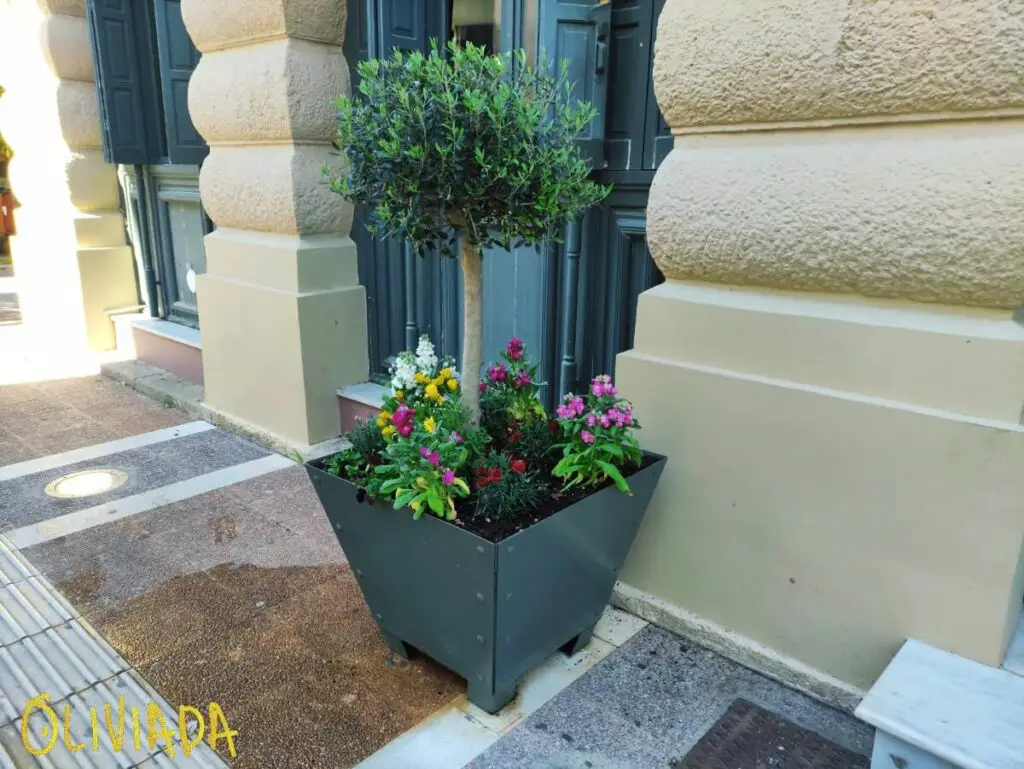
Solutions
If you’ve identified poor drainage as a problem, here are some steps you can take to improve the situation:
Choose a Well-draining Pot
Select a container with ample drainage holes to allow excess water to escape easily. Always check the bottoms of your pot, and ensure the holes are not obstructed. Use a drill to create more holes as needed to control water excess.
Improve Soil Mix
Use a well-draining soil mix, such as a combination of potting mix, perlite, and sand, to encourage proper water drainage. Use a specially made potting mix for olive trees for the best results.
Add a Layer of Drainage Material
Fill the bottom of the pot with a layer of gravel, Styrofoam, lava rock, crushed cans, or stones which helps to drain the water faster.
Just do it once before potting your tree, and you will have fewer problems with olive trees in pots.
Elevate the Pot
Use pot feet, bricks, or a plant caddy to lift the pot off the ground, promoting better air circulation and drainage.
Avoid Overwatering
Ensure you’re following the appropriate watering routine for your olive tree, as outlined in the previously shared Table 1.
2. Nutrient Deficiencies
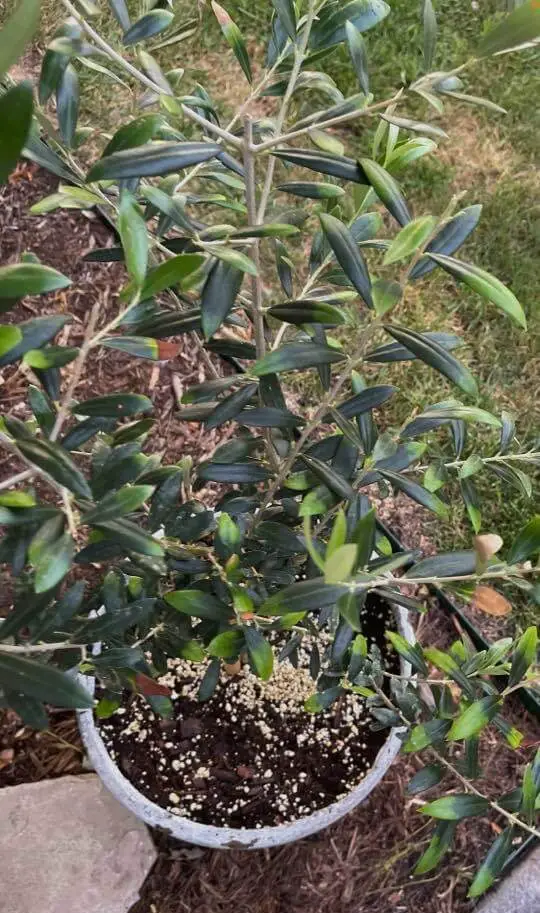
Olive trees frequently suffer from improper mineral nutrition in the soil. The most common nutritional deficiencies of olive trees are nitrogen (N), phosphorus (P), potassium (K), magnesium (Mg), and manganese (Mn). Other essential nutrients such as boron (B), calcium (Ca), copper (Cu), and zinc (Zn) are occasionally found to be deficient if they are not present in the fertilizers applied.
Insufficient nutrients in the soil, a nutrient imbalance, poor soil aeration, a high soil pH, and excessive planting depth can cause nutrient deficiencies.
Symptoms
These are the signs that your potted olive tree may be suffering from nutrient deficiencies:
- Yellow leaves: Leaves turning yellow, particularly between the veins, can indicate a lack of essential nutrients such as nitrogen, iron, or magnesium.
- Reddish or purplish leaves: A reddish or purplish tint to the leaves may signal a phosphorus deficiency.
- Slow growth: If your tree is stunted, it could struggle to access the nutrients it needs to thrive.
- Weak or brittle branches: A lack of nutrients can make weakened branches more prone to breakage.
- Leaf curling: Curled or twisted leaves may indicate a potassium deficiency.
- Drooping leaves: Drooping or sagging leaves can indicate nutrient deficiencies or imbalances.
- Falling leaves: Excessive leaf drops may indicate your tree is not receiving the nutrients needed to maintain healthy foliage.
- Blossom and fruit drop: Nutrient deficiencies can cause your olive tree to shed its blossoms and fruits prematurely.
| Nutrient | Symptoms | Recommended Amendments |
|---|---|---|
| Nitrogen (N) | Yellowing leaves, stunted growth, leaf drop | Balanced, slow-release fertilizer or organic sources |
| Phosphorus (P) | Dark green or purple leaves, weak roots | Phosphorus-rich fertilizer or bone meal |
| Potassium (K) | Yellowing leaf margins, browning, leaf curl | Potassium-rich fertilizer or sulfate of potash |
| Calcium (Ca) | Deformed leaves, weak branches | Gypsum, lime, or calcium-rich organic sources |
| Magnesium (Mg) | Yellowing between leaf veins, leaf curl | Epsom salt or magnesium-rich fertilizer |
| Iron (Fe) | Yellowing between leaf veins, green veins | Iron chelate, iron sulfate, or organic sources |
| Zinc (Zn) | Small leaves, stunted growth, poor fruit production | Zinc chelate, zinc sulfate, or organic sources |
Solutions
If you’ve identified nutrient deficiencies as an issue, here are some steps you can take to ensure your olive tree gets the nutrients it needs:
Test Your Soil
Conduct a soil test to determine which nutrients are lacking and adjust your fertilizer regimen accordingly. For this reason, use a quick and easy soil test kit at home.
Last update on 2024-04-18 / Affiliate links / Images from Amazon Product Advertising API
Use a Balanced Fertilizer
Choose the balanced fertilizer for olive trees and use it at least twice a year during the growing season in spring and for fruit maturing in mid-summer. For the best results, choose a fertilizer with a balanced NPK (10-10-10), but younger olive trees prefer fertilizer with double the nitrogen. This is because younger trees focus their energy on canopy growth, of which the primary nutrient is nitrogen.
For the best results, you can use a fertilizer specially formulated for olive trees:
Last update on 2024-04-18 / Affiliate links / Images from Amazon Product Advertising API
If your soil test reveals specific deficiencies, use a targeted micronutrient supplement (e.g., iron, zinc, or manganese) to address the issue.
Adjust Watering Routine
Overwatering can leach nutrients from the soil, so ensure you follow the appropriate watering schedule for your potted olive tree.
Replenish Soil Periodically
Over time, soil in pots can become depleted of nutrients. Give new soil while re-potted to restore olive tree growth. Give trees in pots a boost by refreshing the top layer of soil annually in spring. Carefully scrape away about 2.5 cm (1 inch) of soil from the surface and replace it with fresh soil – mix in some controlled-release fertilizer granules.
| Month | Fertilizer Type | Notes |
|---|---|---|
| February | Balanced Slow-Release or Specially Formulated for Olives | Apply before the growing season begins; consider a soil test to determine specific nutrient needs |
| May | The same as above | Monitor tree growth and adjust fertilizer application as needed |
| July – August | The same as above | Monitor tree growth and adjust fertilizer application as needed |
| September – October | The same as above | Apply before winter; adjust fertilizer application based on tree growth and health. |
Related articles
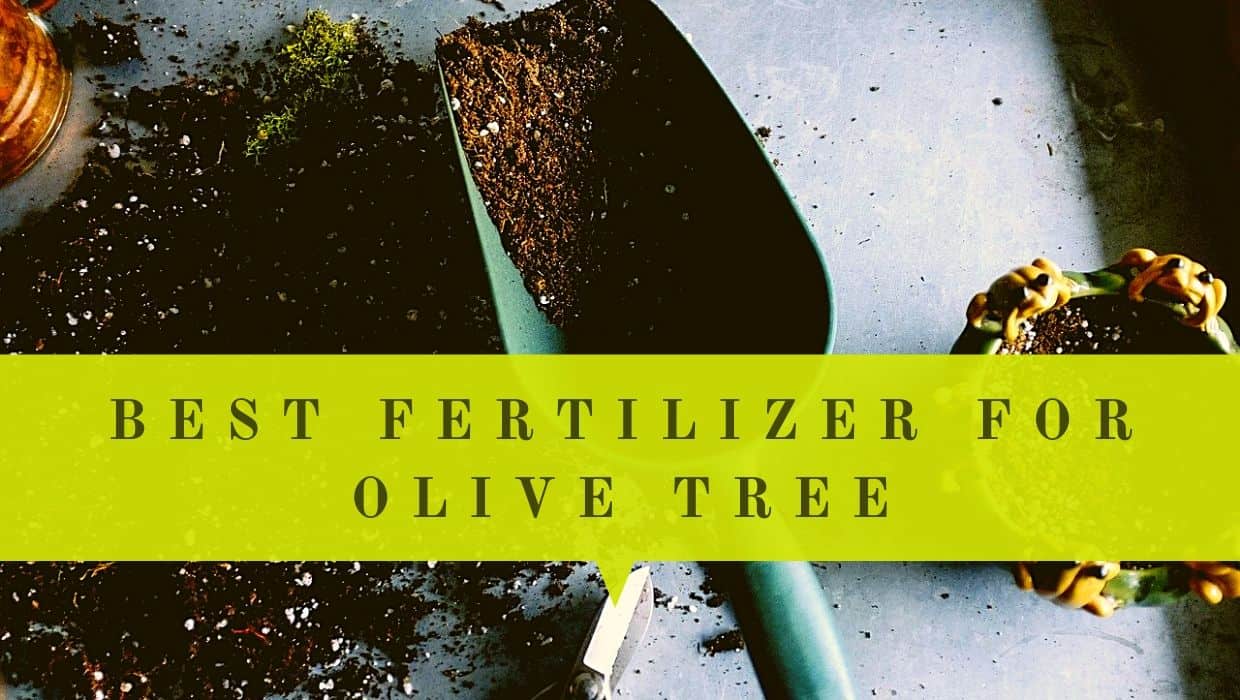
3. Over-fertilization
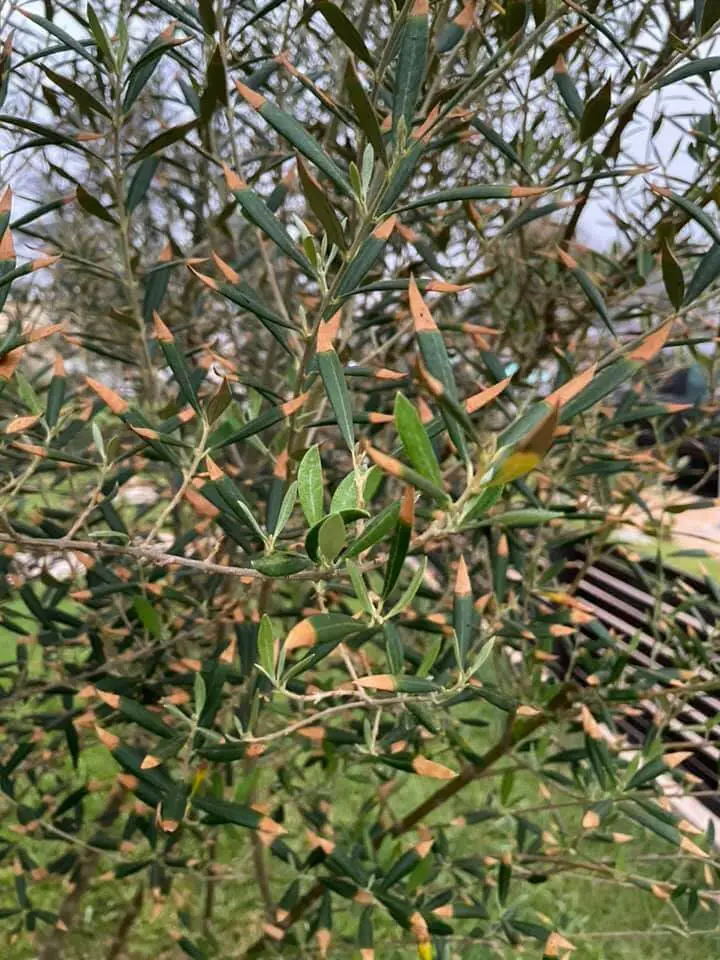
Sometimes olive tree growers use fertilizer spikes for potted olive trees. Generally, they can burn the tree’s roots easily.
Additionally, if the olive grower gives too much fast-release fertilizer to the olive tree, it can cause an overfertilization effect and damage the tree.
Symptoms
Be on the lookout for these signs that your potted olive tree may be overfertilized:
- Leaf scorch: Brown or scorched leaf tips and margins may indicate an excess of fertilizer salts that can damage the roots and leaves.
- Rapid, weak growth: Overfertilization can cause a sudden spurt of growth that is weak and more susceptible to pests or diseases.
- Yellowing leaves: An overabundance of nutrients can lead to a nutrient imbalance, causing leaves to turn yellow, despite adequate watering.
- Root burn: Too much fertilizer can harm the roots, making them less effective at absorbing water and nutrients.
- Reduced flowering and fruiting: Overfertilization can interfere with the tree’s natural cycle, decreasing flower and fruit production.
- Crusty or white residue on the soil surface: Excess fertilizer salts can accumulate on the soil surface, signaling that you may be using too much fertilizer.
- Leaf drop: Overfertilization can cause the tree to shed leaves as it struggles to process the excess nutrients.
- Flower and fruit drop: An overabundance of nutrients may lead to premature flower and fruit drop, as the tree cannot sustain its normal growth cycle.
Solutions
If you suspect overfertilization, consider these tips to restore balance to your potted olive tree’s care routine:
Test Your Soil
Regularly test your soil to ensure you provide the appropriate nutrients and avoid overfertilization.
Use a Balanced Fertilizer
Opt for a slow-release, balanced fertilizer specifically designed for olive trees, such as a 10-10-10 formula (nitrogen-phosphorus-potassium).
Avoid using fertilizer spikes in indoor olive tree pots. On the other hand, using organic fertilizer spikes decreases the chances of damaging your plant. If you use synthetic fertilizer, never exceed the recommended dose.
Flush the Soil
If you suspect overfertilization, water your potted olive tree thoroughly to help flush excess salts from the soil.
Repot the Tree
In extreme cases, you may need to repot your tree in fresh soil to remove excess fertilizer salts and give the roots a fresh start.
Looking for a Personalized Gift?
Adopt an OLIVE TREE in Greece –
Receive Premium Olive Oil!
4. Soil pH
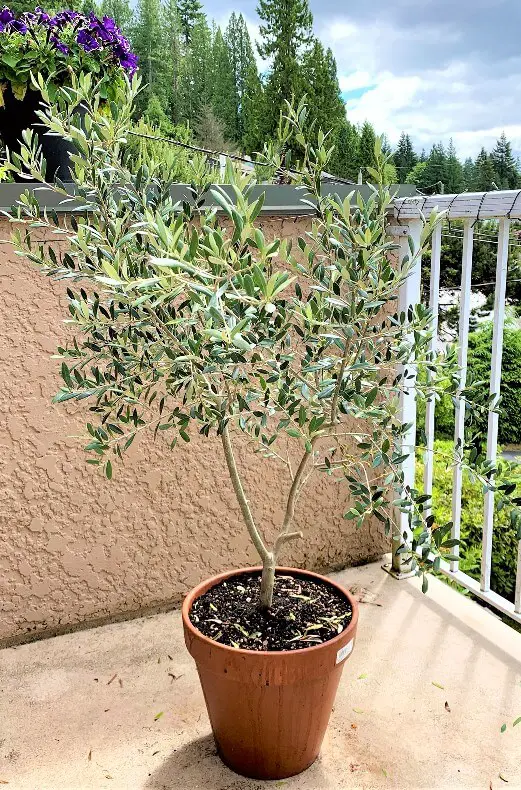
If an olive tree’s soil pH is either too acidic or alkaline, the nutrients will become bound in the soil and inaccessible to the roots of the olive tree. This can lead to various problems, and without taking any action, it will cause a poor growth and health issues.
Symptoms
- Yellowing leaves: Discoloration in the foliage can indicate that your tree has trouble absorbing nutrients due to an imbalanced soil pH.
- Slow or stunted growth: An improper soil pH can hinder your tree’s ability to grow and develop, resulting in slower and less vigorous growth.
- Poor fruit development: Imbalanced soil pH can affect nutrient uptake, leading to underdeveloped or scarce fruit production.
- Weak overall appearance: When the soil pH is not within the ideal range, your olive tree may appear less robust and less healthy overall.
- Falling leaves: Leaf drops could be a symptom of your tree experiencing stress from an imbalanced soil pH, affecting nutrient absorption.
- Flower and fruit drop: If the soil pH is off, your olive tree may struggle to maintain its flowers and fruits, leading to premature shedding.
Solutions
Testing Soil pH
Check for soil pH by using pH strips or a pH meter at least once per year. The goal is to keep the olive tree’s soil balanced: olive trees prefer a soil of pH 6 – 8, but it may slightly differ based on the cultivar.
To determine your potted olive tree’s soil pH, you can purchase a soil pH testing kit from your local garden center or online. These kits are usually affordable and easy to use.
Last update on 2024-04-18 / Affiliate links / Images from Amazon Product Advertising API
Adjusting Soil pH
Use lime (calcium carbonate) and alkaline materials like charcoal, biochar, or wood ash, if you test your olive tree’s soil is too acidic (pH below 7.0).
Opposite, use sulfur or acidifying organic matter such as sand, coffee ground, or peat moss if you test your olive tree’s soil is too alkaline (pH above 8.5).
Relevant articles
Best soil for olive trees in pots
How to prepare soil when planting olive trees
III. Olive Tree Leaves Problems
In general, olive leaves can tell us about many problems with olive trees in pots.
For instance, you notice your olive tree leaves turn yellow or brown. If it happens only to a few leaves, I wouldn’t worry about that – it may be a natural seasonal change. However, if you observe them closely and you notice that olive leaves turn yellow with brown blotches moving in from the edges to the tips. This may be leaf necrosis – a sign of drought stress – and if no action is taken, the leaves will fall off, and the tree could die too.
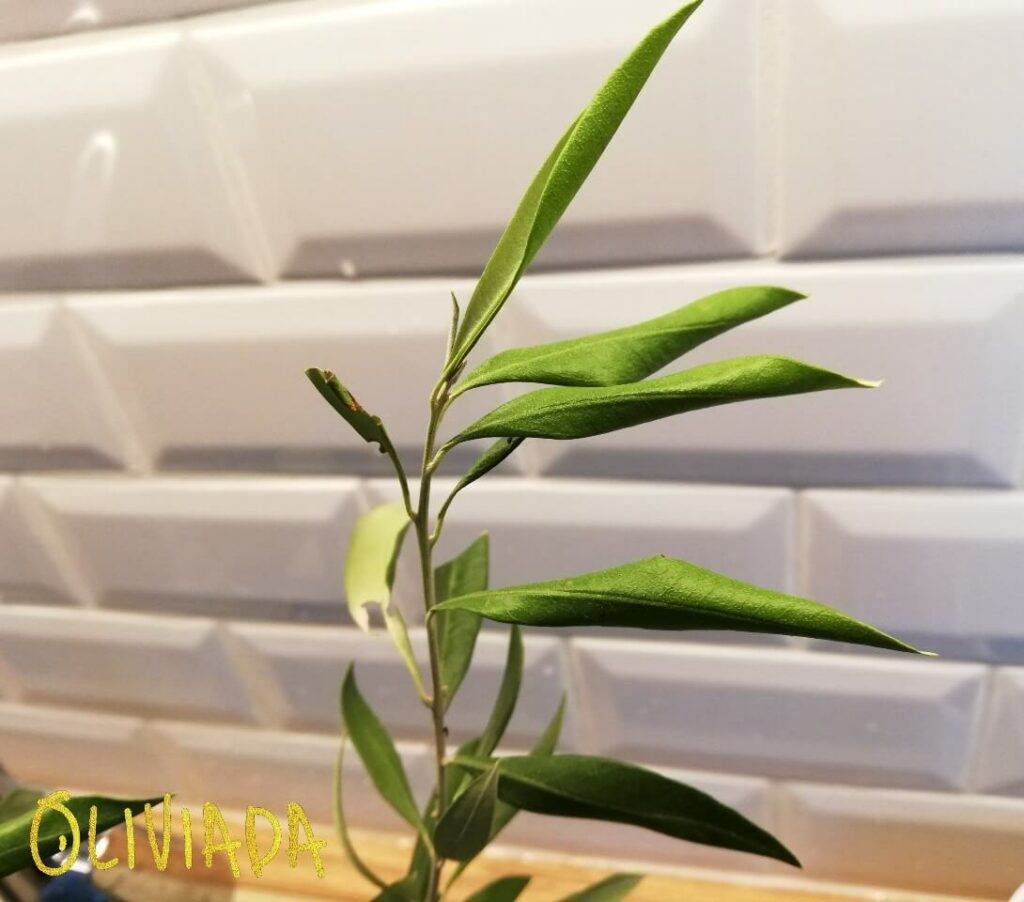
Another common problem with olive trees in pots is olive tree dropping leaves. Mainly it happens due to water issues: over-watering or under-watering.
Overwatering
Olive trees love water; however, they hate to be too wet and in constant moisture. Particularly olive trees in pots since they have limited space in a pot.
So if your olive tree is overwatered, it starts losing leaves. Typically, leaves get yellow and start dropping. Read more in section 1.
Underwatering
Therefore, olive trees sometimes lose their leaves in summer. And the reason is that the tree gets too dry too often. So the olive tree leaves dry out and starts dropping. Read more in section 2.
Olive tree leaves can tell us so much about tree health and growing conditions. In addition, to signaling drought stress, they can show us if the tree is experiencing nutritional deficiencies, water issues, or even if it is fighting pest and disease problems. So our job as gardeners is to recognize the symptoms and to satisfy olive trees’ needs before it’s too late.
For this reason, I have gathered lots of helpful information for olive tree growers and created separate articles depending on olive tree leave issues:
- Olive Tree Leaves Turning Brown
- Olive Tree Leaves Turning Yellow
- Olive Tree Leaves Curling
- Olive Tree Leaves Dropping Off
- White Stuff on Olive Leaves
- Olive Tree Leaves Yellow with Black Spots
IV. Pests
Though olive trees are one of the most pest-resistance trees, there are sometimes problems with pets of pot-grown olive trees. The most common pests are olive lace bugs, fruit flies, scale insects, mites, and aphids.
| Pests | Symptoms | Prevention and Control Measures |
|---|---|---|
| Aphids | Distorted leaves, weakened growth, honeydew secretion, sooty mold growth | Inspect regularly, gently scrape off insects with a soft brush or cloth, and use horticultural oil or insecticidal soap if necessary |
| Scale Insects | Sap-sucking, honeydew secretion, sooty mold growth, weakened plant | Check for infestation, dislodge with strong water spray, and use miticide or insecticidal soap if necessary |
| Olive Fruit Fly | Small punctures on fruit, presence of adult flies, reduced fruit quality | Leaf stippling, yellowing, and fine webbing on leaves and stems |
| Spider Mites | Inspect regularly, remove with water spray or damp cloth, and use insecticidal soap or neem oil if necessary | Inspect regularly, remove with water spray or damp cloth, and use insecticidal soap or neem oil if necessary. |
| Olive Lace Bugs | Discolored leaves, leaf drop, weakened growth | Inspect the tree regularly, use a strong spray of water to remove bugs, and apply insecticidal soap or horticultural oil if necessary |
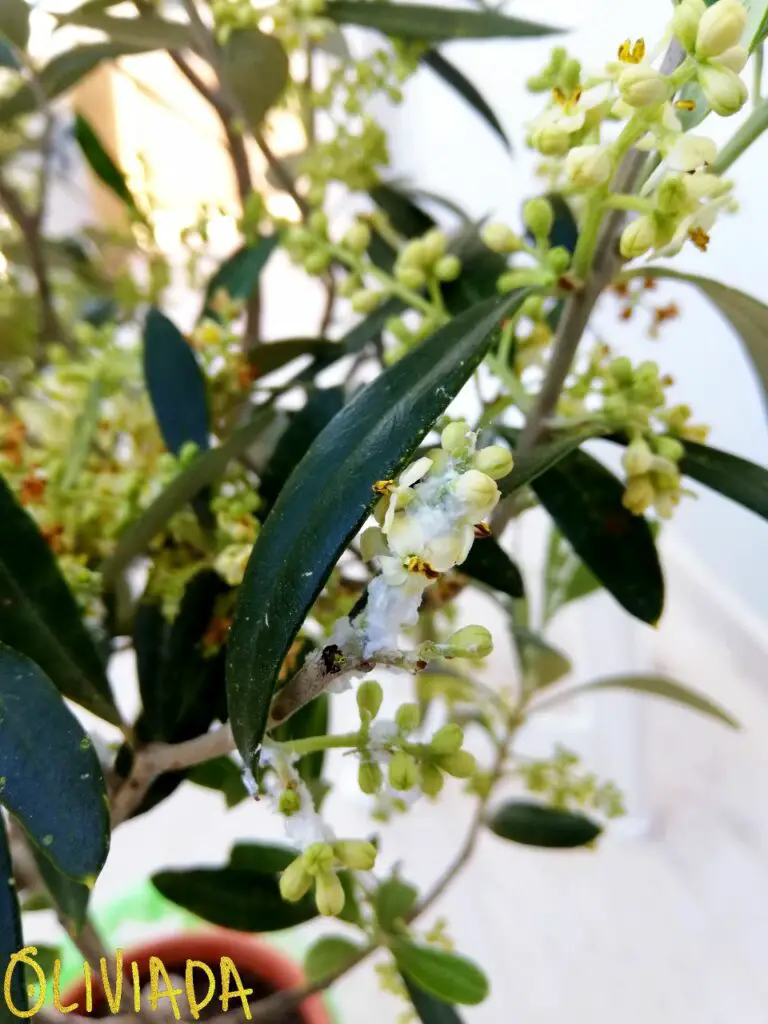
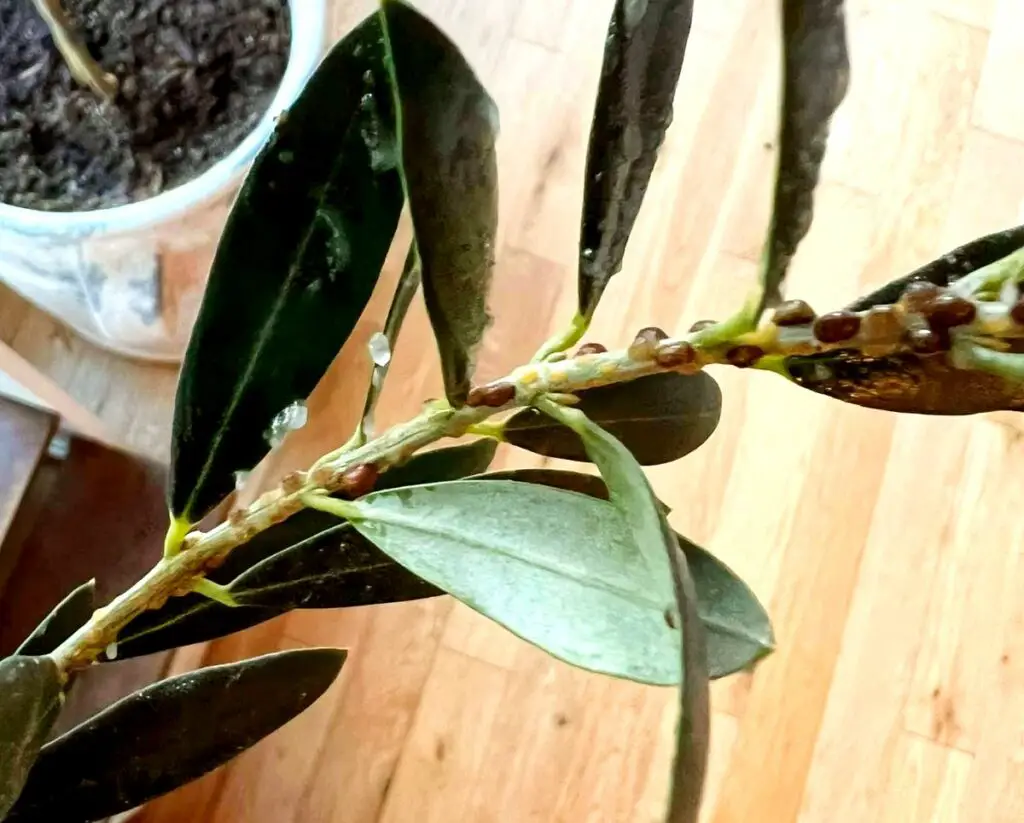
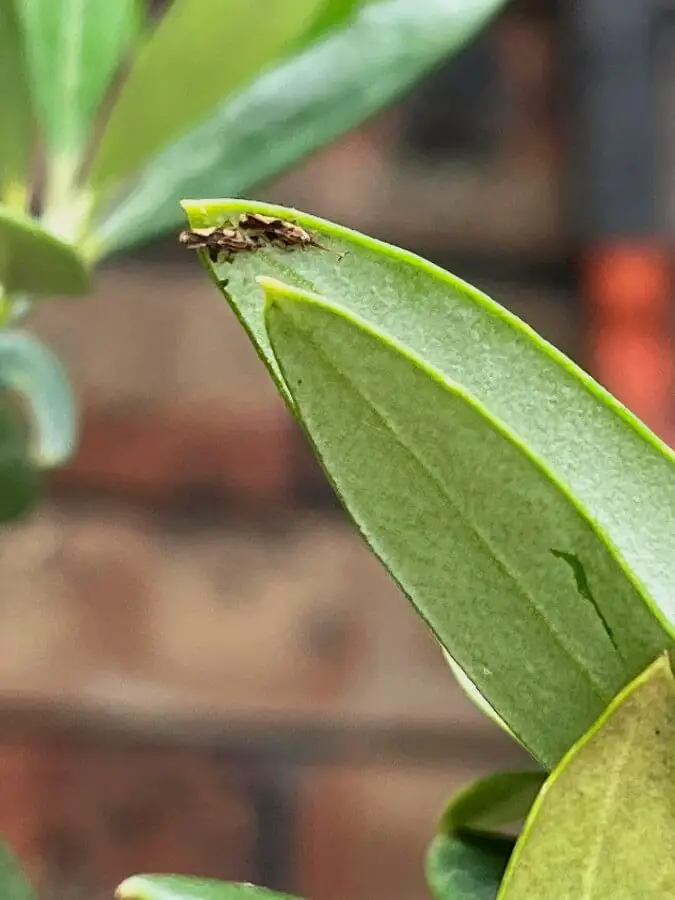
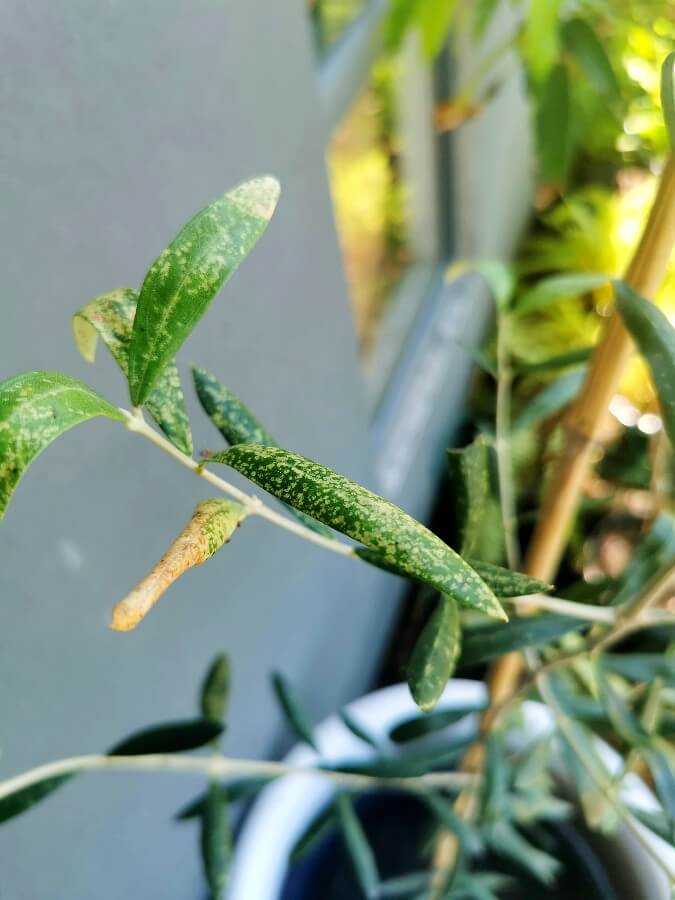
Solutions
Here are some fantastic solutions that can help you manage those unwanted visitors and keep your trees thriving:
Cultural methods
Let’s start by creating a healthy environment that makes it harder for pests to set up a hub.
- Keep an eye on your trees, regularly checking for any signs of pests.
- Treat your olive trees like royalty with the right watering, fertilization, and pruning.
- Move your potted plants around occasionally to minimize pest buildup.
- Keep the area around your tree tidy by removing fallen leaves or debris.
Biological methods
Utilize natural predators and beneficial insects to control pest populations.
- Welcome beneficial insects, like ladybugs, lacewings, or predatory mites, to keep those aphids, scale insects, and spider mites in check.
- Encourage birds to visit your garden by providing nesting sites or bird feeders – they can be great allies against pests.
Physical methods
Manually remove pests or create barriers to protect your plants.
- Blast away aphids, spider mites, and lace bugs with a powerful water spray.
- Gently brush or wipe off scale insects.
- Set up barriers, like sticky tape or copper bands, to stop pests from climbing your trees.
Chemical methods
Apply chemical treatments, such as insecticides or miticides, to control pest infestations.
- Try insecticidal soap or horticultural oil for aphids, scale insects, and lace bugs. They’re generally eco-friendly and kind to beneficial insects.
- Tackle spider mites with a miticide.
- Use organic bait sprays to control those pesky olive fruit flies.
- Always follow the manufacturer’s instructions, and consider the impact on the environment and friendly insects.
By combining these solutions and keeping a close eye on your potted olive trees, you’ll be well on your way to managing pests and keeping your trees happy and healthy.
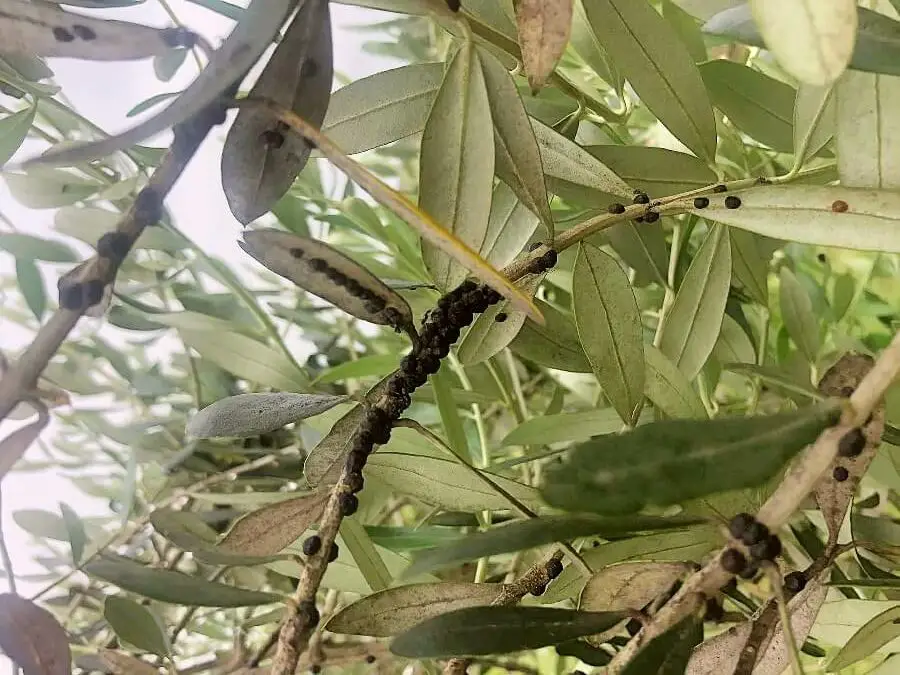
Relevant articles
How to get rid of scale insects
V. Diseases
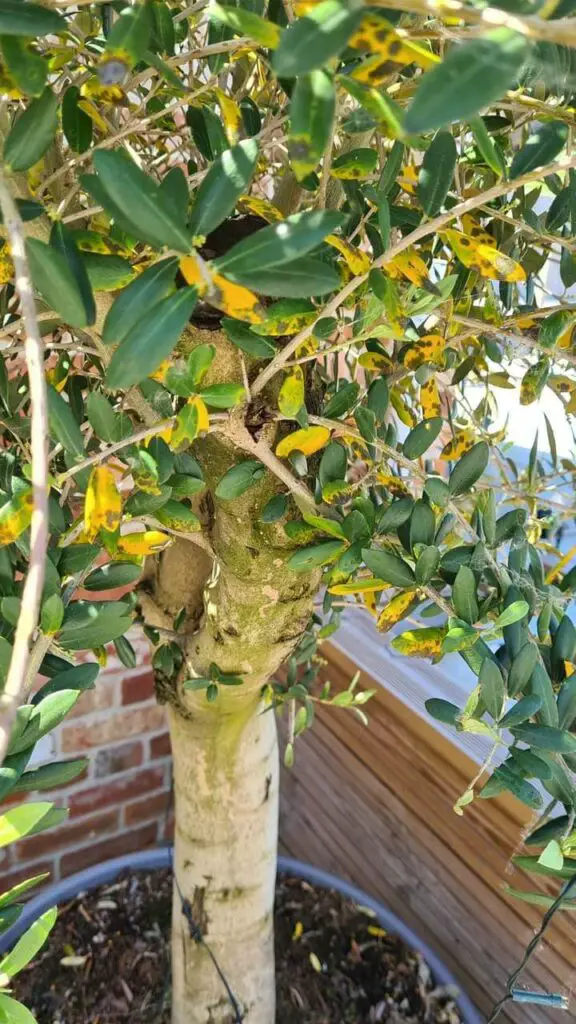
The most common diseases that can affect your potted olive trees include Peacock Spot, Olive Knot, Verticillium Wilt, Anthracnose, Root Rot, and Leaf Spot/Blight. Each of these diseases presents unique symptoms; in most cases, being infected with a tree fungus will result in loss of vigor and discoloration of leaves. So it’s crucial to monitor your tree’s health and address issues as soon as they arise.
| Disease | Symptoms | Prevention | Treatment |
|---|---|---|---|
| Peacock Spot | Olive-green to black spots on leaves | Fungicides, removing affected leaves | Wilting, yellowing, and browning of leaves |
| Olive Knot | Galls or knots on branches, twigs, and trunks | Prune infected branches, use bactericides | Balanced pruning, proper watering, air circulation |
| Verticillium Wilt | Resistant varieties, soil solarization, avoid stress | Remove affected branches, and maintain tree health | Fungicides remove affected fruit and branches |
| Anthracnose | Dark, sunken lesions on fruit, leaves, and twigs | Proper pruning, avoid overhead watering | Fungicides, remove affected fruit and branches |
| Root Rot | Wilting, yellowing leaves, black/brown mushy roots | Good drainage, avoid overwatering | Fungicides, replace infected soil, improve drainage |
| Leaf Spot/Blight | Discolored, yellow or brown spots on leaves | Balanced pruning, avoid overhead watering | Fungicides, removing affected leaves |
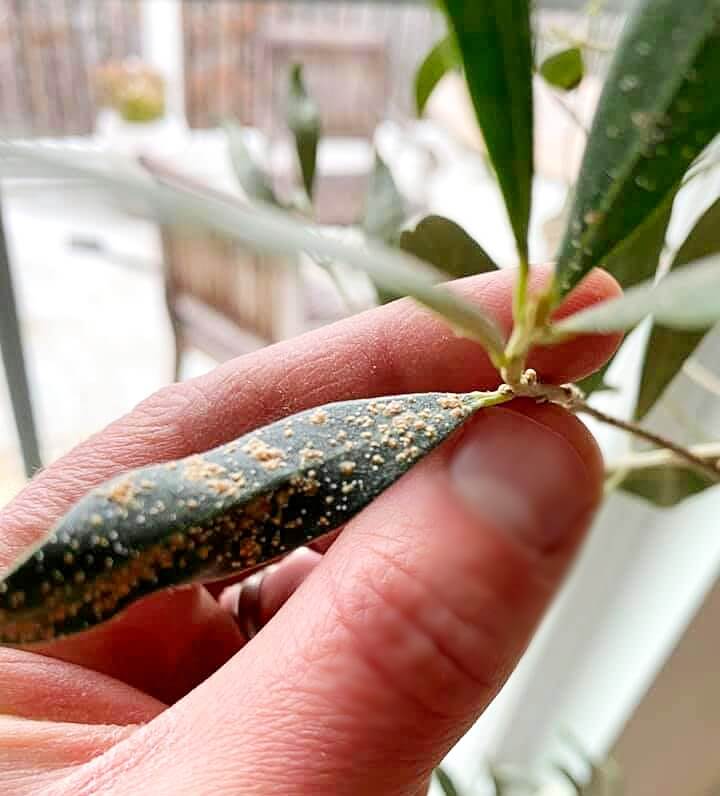
Solutions
We can take several solutions and preventive measures to keep our trees healthy.
Proper Watering
Avoid overwatering your olive tree, as this can create conditions favorable for fungal diseases. Allow the soil to dry out slightly between waterings.
Good Air Circulation
Prune your tree to promote air circulation and prevent the build-up of moisture, which can encourage disease development.
Regular Inspection
Routinely check your olive tree for signs of disease and take prompt action if you notice any symptoms.
Sanitation
Keep the area around your potted olive tree clean and free of fallen leaves, debris, and weeds that can harbor pathogens.
Fungicides
If your olive tree is affected by a fungal disease, first, prune off the most infected parts of the tree. Then, apply a fungicide specifically designed for olive trees.
For the best advice, is better to speak with the arborist, and he/she will be able to identify if the fungus is harmful and what treatment is required.
Disease-resistant Varieties
When choosing an olive tree, opt for varieties that are resistant to common diseases.
| Olive Variety | Resistance to Peacock Spot | Resistance to Olive Knot | Resistance to Verticillium Wilt | Resistance to Anthracnose | Resistance to Root Rot | Resistance to Leaf Spot/Blight |
|---|---|---|---|---|---|---|
| Arbequina | High | Medium | High | Medium | High | Medium |
| Frantoio | Medium | High | Medium | High | Medium | High |
| Leccino | High | High | High | High | High | High |
| Manzanillo | Medium | Medium | Medium | Medium | Medium | Medium |
| Picual | High | High | High | High | High | High |
| Koroneiki | High | High | High | Medium | High | Medium |
| Picholine | Medium | High | Medium | High | Medium | High |
| Pendoline | High | High | Medium | Medium | High | Medium |
| Kalamata | Medium | Medium | High | Medium | High | Medium |
| Maurino | High | High | High | High | High | High |
- High resistance refers to an olive variety’s strong ability to withstand or tolerate a specific disease, making it less likely to be affected by that disease. These varieties exhibit a high level of genetic resistance and often perform well even in the presence of the disease.
- Medium resistance indicates that the olive variety has some ability to tolerate or resist a specific disease, but it may still be affected under certain conditions or if the disease pressure is high. These varieties may require additional care, such as proper cultural practices and monitoring, to reduce the risk of disease infection.
Note: Environmental factors and cultivation practices can influence resistance levels. Consult local experts and resources for the best variety selection based on your specific region and conditions.
VI. Environmental Factors
1. Transition Stress
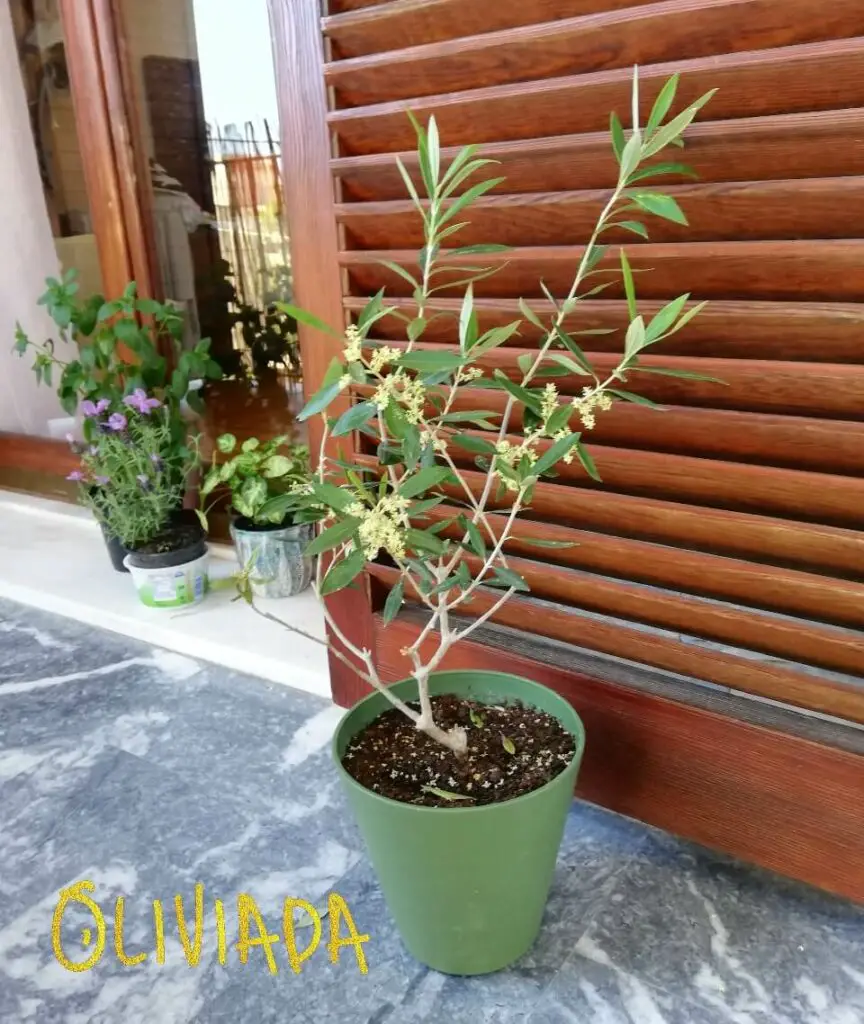
When olive trees are exposed to significant environmental changes, they might need time to adjust to the new conditions. Olive tree becomes stressed after relocation or re-potting, and their leaves start drooping or falling off. This is a negative effect of transition shock. Olive trees experience stress from moving or establishing a new root system.
Factors such as light, temperature, and humidity can all contribute to transition stress, resulting in temporary setbacks for your tree.
Symptoms
During this adjustment period, you may notice the following signs:
- Leaf drop: Shedding leaves can indicate your tree is experiencing stress as it adjusts to a new environment.
- Yellowing or browning leaves: Discolored leaves may indicate that your tree struggles with light, temperature, or humidity changes.
- Wilted or drooping leaves: Leaves that wilt or droop could signal the tree’s difficulty adapting to its new surroundings.
- Reduced growth: A slowdown in growth may be a temporary setback as the tree acclimates to the new conditions.
- Flower and fruit drop: Premature shedding of flowers and fruits might occur when the tree is coping with environmental changes and trying to conserve energy during the transition.
Solutions
To support your olive tree during this transition, here are a few helpful tips to ensure it bounces back quickly:
Gradual Exposure
Introduce your tree to its new environment slowly, especially when moving between indoor and outdoor spaces. Gradually increase the time it spends in the new location over several days to help it acclimate.
For example, when relocating to a new place, put your olive tree in a partially shaded spot for a few days before moving into full sun or outside for a few hours a day until it has adjusted to its new position.
Monitor Light and Temperature
Keep a close eye on light exposure and temperature changes during the transition. Ensure your tree gets enough light, but avoid drastic temperature fluctuations.
Humidity Control
If you’re moving your tree indoors, consider using a humidifier to maintain a comfortable level of humidity, as indoor environments can often be drier than outdoors.
Proper Watering
Pay close attention to your tree’s water needs during the transition period. Adjust your watering schedule if necessary, ensuring the soil doesn’t become too dry or too wet. Use a moisture meter to measure the moist in the pot.
Patience
Finally, be patient! It might take some time for your olive tree to adjust, but it’ll bounce back and thrive in its new environment with proper care and attention.
2. Insufficient Light
Like other Mediterranean trees, olive trees are sun-lovers. In fact, they need a good 6-8 hours of direct sunlight daily to thrive truly. They can become leggy and weak and produce fewer olives when they don’t get enough sun rays.
Symptoms
- Leggy growth: Your tree may develop long, spindly branches with more significant spaces between leaves.
- Yellowing leaves: Lack of sunlight can cause leaves to turn yellow or pale green.
- Green leaves drop: Insufficient sunlight can result in leaf drops.
- Weak stems: Your olive tree may have weaker, more fragile stems that struggle to support the plant.
- Reduced fruit production: If your tree lacks light, it might drop flowers and fruits and produce fewer olives.
- Slow growth: Insufficient sunlight can lead to stunted growth or a complete halt in development.
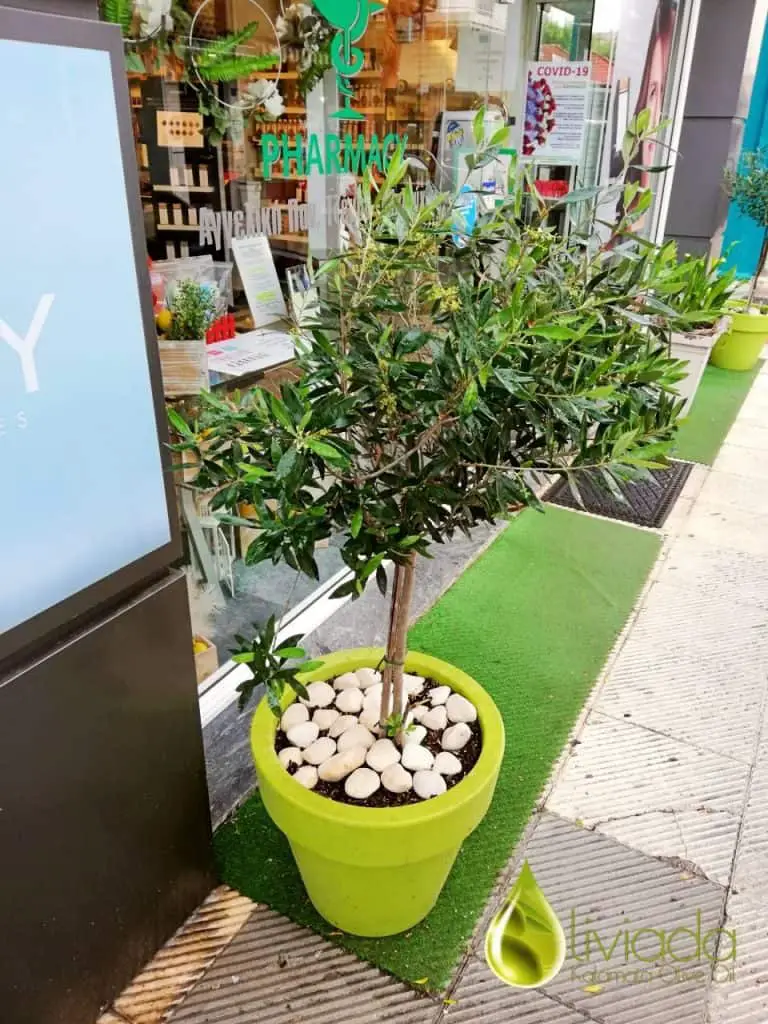
Solutions
Now that you know the symptoms, let’s dive into some solutions to make sure your potted olive tree gets all the sunlight it needs:
Finding the Perfect Spot
When it comes to placing your potted olive tree, think sunny thoughts. Look for a spot in your garden, patio, or balcony that gets consistent, direct sunlight throughout the day.
Don’t worry if you’re an indoor olive tree grower, though—just put your tree near a south-facing window that gets plenty of light, and it’ll be good to go.
Keep an Eye on the Shadows
As the seasons change, so do the shadows. It’s a good idea to check your olive tree’s sunny spot every few months to ensure it’s still getting enough light. If you notice the sun shifting, don’t hesitate to move your potted tree to a sunnier location.
Supplemental Lighting for Indoor Trees
If you’re growing your olive tree indoors and struggling to provide enough natural light, don’t fret! You can always use supplemental lighting, like grow lights, to give your tree a helping hand. Just make sure to follow the manufacturer’s guidelines for the best results.
When a tree receives insufficient natural sunlight, a simple T-5 fluorescent grow light system can provide enough supplemental light. For instance, the T5 system delivers performance, flexibility, and high-lumen output in any growing environment. In addition, these systems allow you to choose multiple hanging configurations to meet your home design.
Relevant articles
Direct sunlight for olive trees indoors
3. Sunburn
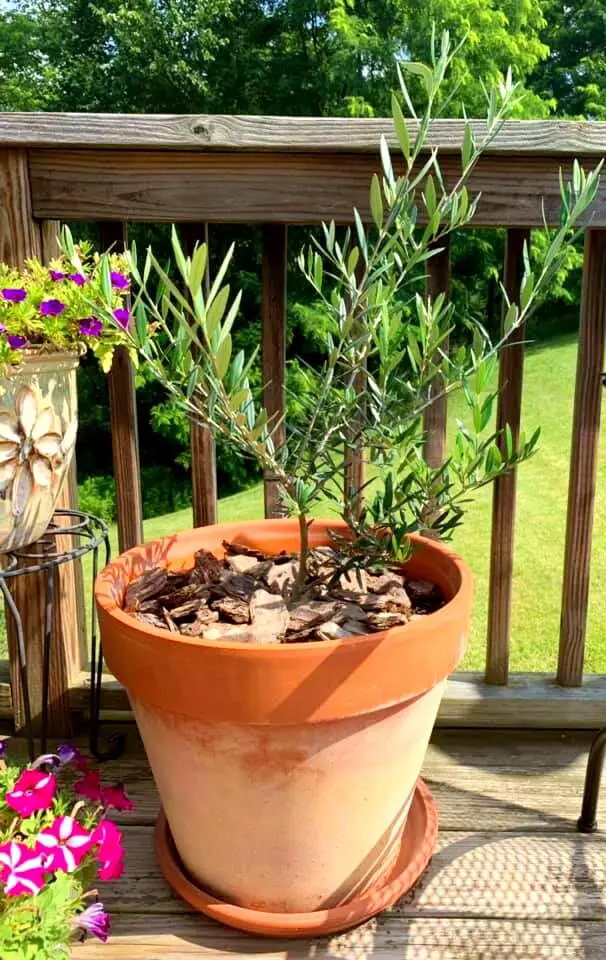
When you do move your potted olive trees outside, do be aware that a sudden change in light levels can cause ‘sunburn’. Because too dramatic a change in light levels can lead to blanching of the olive leaves and some leaf loss, your olive tree will recover and put on new growth over time.
Also, olive seedlings and olive trees that have been indoors for extended periods (including those from garden centers!) must slowly get used to the sun. In other words, the number of hours of direct sunshine must be gradually increased. The places (leaves or branches) that have already been burned do not recover.
Exposing the olive tree to too much light can interfere with its normal production cycle and limit its ability to produce fruit.
Symptoms
Signs that your olive tree may be experiencing sunburn include:
- Yellowing or browning leaves: Discolored leaves can signify sunburn, indicating that the tree has been exposed to excessive sunlight or heat.
- Crispy, dry leaves: Leaves that are dry and brittle to the touch may be experiencing sunburn, as the intense sunlight dehydrates and damages the leaf tissue.
- Bark cracking or splitting: Sunburn can cause the bark to crack or split as the tree’s outer layer struggles to cope with the heat and intense sunlight.
- Branch dieback: When sunburn damages the tree’s branches, it can lead to dieback, where the affected branches wilt, turn brown, and eventually die.
- Leaf drop: Falling leaves can indicate that the tree is experiencing stress, such as sunburn, causing it to shed foliage to conserve resources.
- Flower and fruit drop: Sunburn stress may lead to the premature shedding of flowers and fruits as the tree reallocates energy to protect itself from further damage.
Solutions
Here are some handy tips to help prevent sunburn and keep your potted olive trees healthy and happy:
Partial Shade
During the hottest part of the day, try to provide your potted olive tree with some shade, especially if it’s a young tree or recently transplanted. A well-placed patio umbrella or shade cloth can do the trick.
Gradual Sun Exposure
If your tree is new to your garden or you’re moving it from a shaded area, introduce it to direct sunlight gradually. Start with a few hours of sun per day and increase the exposure over a week or two, allowing the tree to acclimate.
Proper Watering
Make sure your olive tree is well-watered, especially during hot weather. A well-hydrated tree will be more resilient to sunburn.
Mulching
Apply a layer of mulch around the base of your potted olive tree. Mulch can help regulate soil temperature and retain moisture, providing additional protection against sunburn.
4. Freezing Weather
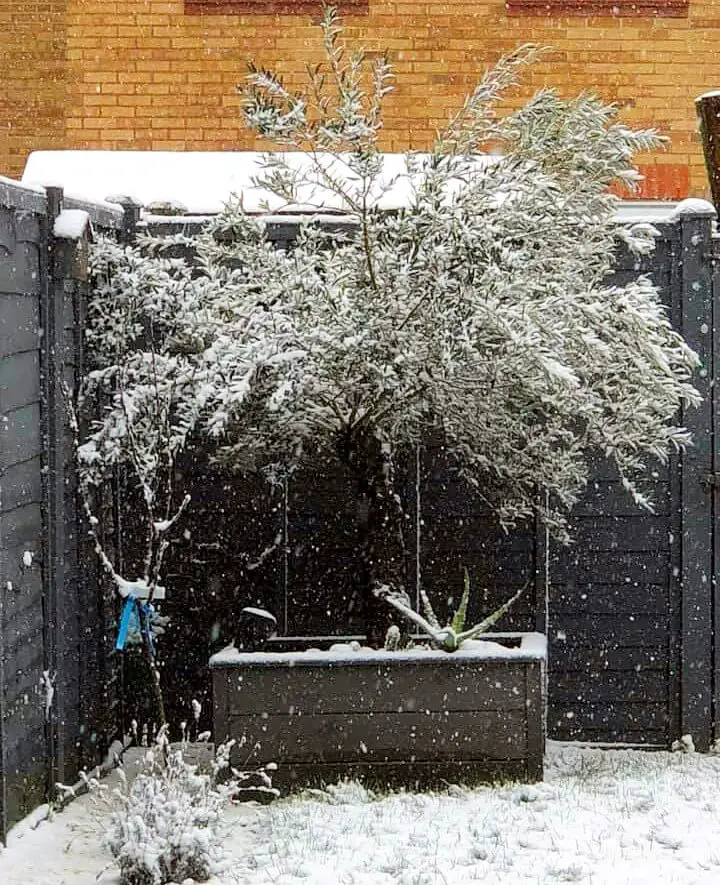
While an olive tree planted in the ground can take extreme frost and cold for some time, an olive tree in a pot or in a container cannot. Olive trees in pots can suffer severe damage at temperatures below 14 degrees F (-10 °C).
In exposed gardens, olive trees in pots winter care are necessary to protect roots growing near the edges vulnerable to freezing temperatures.
Symptoms
Here are signs that your potted olive tree may be suffering from freezing weather damage:
- Browning or blackening leaves: Discolored leaves indicate that freezing temperatures have damaged the tree’s foliage.
- Wilted or drooping leaves: Limp leaves and drooping can indicate cold stress affecting the tree’s overall health.
- Leaf drop: When leaves fall off the tree during cold weather, it’s a symptom that the tree is struggling to cope with the freezing temperatures.
- Branch dieback: Cold damage can cause branches to wither, turn brown, and eventually die, leading to dieback.
- Splitting or cracking bark: Bark that cracks or splits is a sign of the tree’s outer layer struggling to withstand freezing temperatures.
- Yellowing leaf veins: When the leaf veins of an olive tree turn yellow, it indicates that the tree cannot absorb nutrients due to cold temperatures.
- Flower and fruit drop: Cold stress can lead to the premature dropping of flowers and fruits as the tree tries to conserve energy and resources.
Solutions
Insulation
When freezing weather threatens, provide two layers of protection by covering the tree with a blanket and then a plastic or bubble wrap sheet. Remove the covering the following day after the freezing weather has gone.
Mulching
Apply a layer of mulch around the base of your potted olive tree to help insulate the soil and maintain a more consistent temperature.
Move Your Tree Inside
For protection from prolonged periods of freezing weather, you may consider moving olive trees indoors for winter. Bringing a large potted olive tree is a job for two people at least – don’t try to do it alone because you may injure your muscles if you are not careful.
If you moving a tree alone, attach wheels to the bottom of the pot or use a hand truck to transfer the tree.
Also, you can move your potted olive tree to a more sheltered location near a wall or under an overhang to shield it from cold winds and temperature fluctuations.
Check Overall Health
Before bringing any trees indoors, consider their health. Be sure to check your olive tree for any pests. If your olive tree does have pests, I recommend treating it for two weeks before moving it indoors. Once the pests are under control, you can prep your plants for going inside.
Sunniest Location
Before moving your olive trees in pots indoors, ensure you have the right location for them. They will thrive best if placed near a southern-facing window with bright sunlight coming inside.
Use a spray bottle and mist the leaves every few days to provide more humidity for your olive trees, especially when the heat is running and your home feels dry. If there is not enough moisture in the area, the foliage on your trees will become dry and crispy and may even turn brown. Water thoroughly when the soil doesn’t feel moist to the touch.
5. Abrupt Temperature Shifts
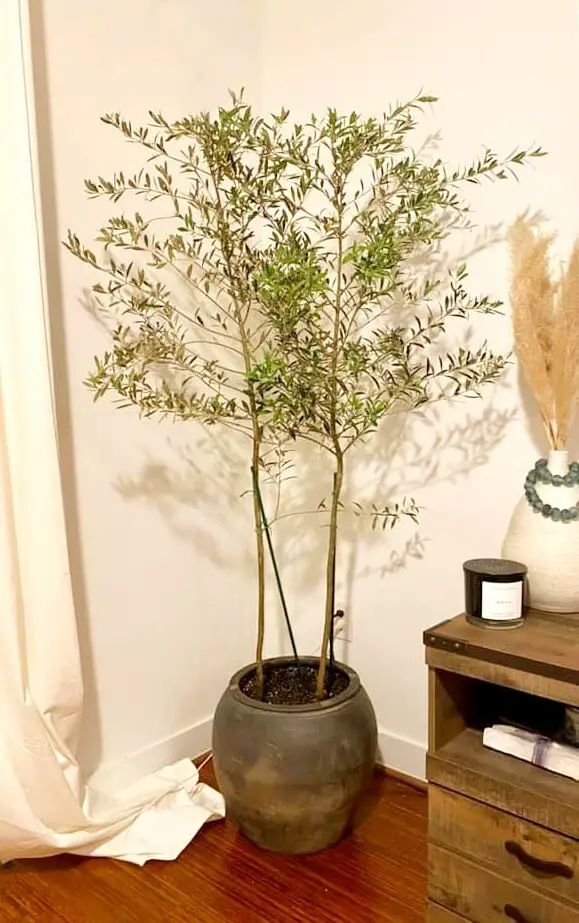
Olive trees dislike abrupt temperature shifts, so protect them from chilly drafts and blazing heaters. Opening the nearby door or window for them on a cold day stresses olive trees (and other plants). Stressed olive trees are susceptible to diseases and pests.
Potted olive trees are particularly susceptible to temperature shifts because they have a limited root system and are more exposed to the elements than trees planted in the ground.
Symptoms
Keep an eye out for these signs that your potted olive tree may be struggling with abrupt temperature shifts:
- Wilted or drooping leaves: Limp, sagging leaves can indicate that the tree is stressed from sudden temperature changes.
- Yellowing or browning leaves: Discolored leaves are a sign that the tree is struggling to adjust to abrupt temperature shifts.
- Leaf drop: When leaves fall off the tree, it can be a symptom of the tree attempting to conserve energy during temperature fluctuations.
- Flower and fruit drop: The premature dropping of flowers and fruits can be a result of the tree reallocating resources due to temperature stress.
- Stunted growth or development: Hindered growth and development of the tree may occur when it’s unable to cope with rapid temperature changes.
Solutions
Here are some tips to help your trees adjust and stay healthy:
Acclimate Gradually
If possible, expose your potted olive tree to gradually increasing or decreasing temperatures, allowing it to adapt slowly to the new conditions.
Always, it’s best to keep your tree away from spots near exterior doors, radiators, fireplaces, and ovens where temperature fluctuations can happen.
Shade and Shelter
Provide temporary shade or shelter for your tree during extreme heat or cold to buffer the impact of temperature changes.
Mulching
Apply a layer of mulch around the base of your potted olive tree to help insulate the soil and maintain a more consistent temperature.
Monitoring Watering
Adjust your watering routine based on the temperature, providing more water during hot periods and less during cold snaps to help your tree cope with the changing conditions.
6. Low Humidity
Olive trees need a certain level of humidity to thrive. Potted olive trees can be more sensitive to low humidity because they are more exposed to indoor environments or other locations where humidity levels may fluctuate.
The biggest problem with low humidity is in the winter with the heat on. Low humidity indoors saps moisture from the olive leaves, causing the tips to dry out and turn brown, with a dying appearance.
Symptoms
Be on the lookout for these signs that your potted olive tree might be struggling with low humidity:
- Crispy or curled leaves: Dry leaves and curling indicate a lack of moisture in the air, causing the tree to lose more water than it can take up.
- Browning leaf edges: Discoloration along the edges of leaves is a sign that the tree is struggling to maintain proper hydration due to low humidity levels.
- Leaf drop: When leaves fall off the tree, it can be a symptom of the tree’s attempt to conserve water in response to insufficient humidity.
- Reduced growth: Hindered growth can occur when inadequate humidity levels limit the tree’s ability to photosynthesize.
- Flower and fruit drop: The premature dropping of flowers and fruits can result from the tree reallocating resources due to low humidity stress.
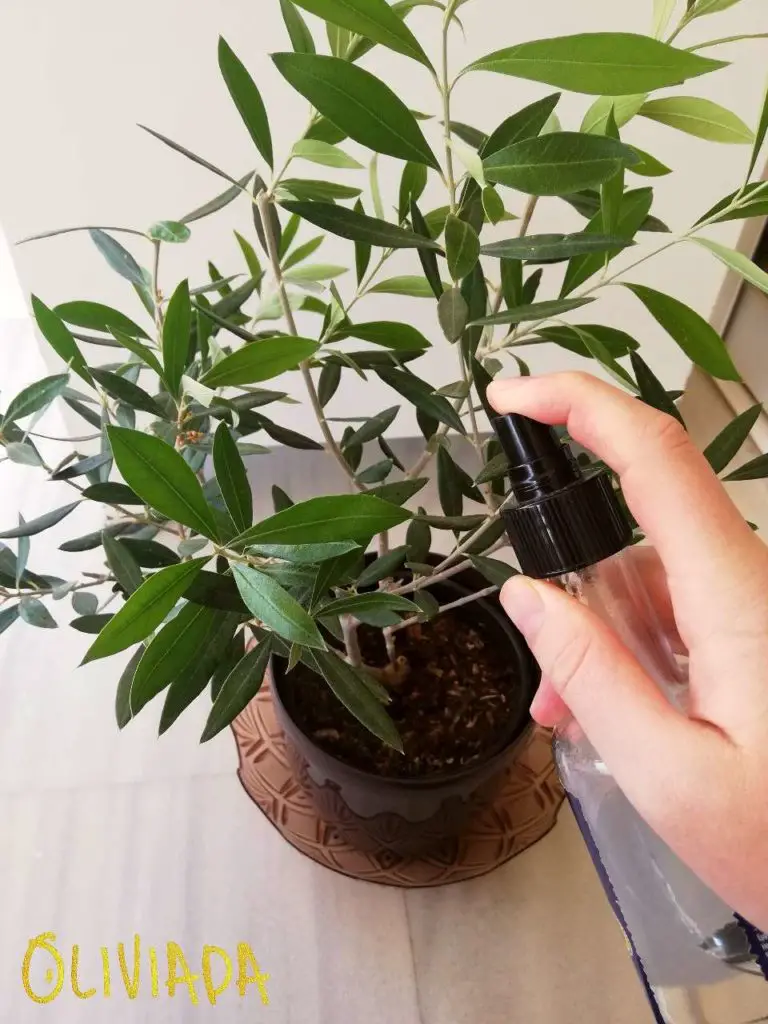
Solutions
Don’t let low humidity put a damper on your potted olive tree’s success! Here are several great solutions:
Misting
You can mist your olive tree indoors with a spray bottle to increase humidity around its leaves. In winter, you can do it daily if the heating is on. On the other hand, if you want to cut down on time spent misting, invest in a humidifier.
Humidity Tray
Place your potted olive tree on a tray filled with water and pebbles to create a humid microclimate.
Grouping Plants
Group your potted olive tree with other moisture-loving plants to increase the overall humidity in the area.
Humidifier
Consider using a humidifier near your potted olive tree to maintain consistent humidity levels, especially during the winter when indoor air is drier.
VII. Olive Tree Care
1. Lack of Pruning
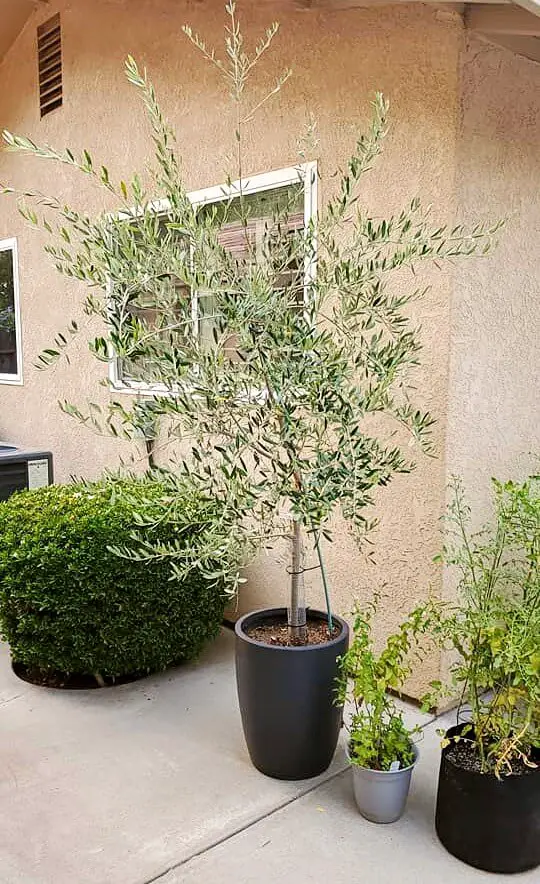
Olive trees indoors generally don’t require a lot of pruning, but you need to cut away some branches occasionally. Pruning away weak, broken, or damaged branches help your olive tree stay healthy. You may also want to prune to shape your olive tree and control its size.
Pruning your potted olive trees is not just about aesthetics; it’s also vital for their overall health and productivity. Regular pruning helps promote better air circulation, prevents diseases, and encourages the growth of healthy, strong branches.
Symptoms
If you’re not sure whether your potted olive tree needs pruning, keep an eye out for these telltale signs:
- Overcrowded branches: Too many branches nearby can make it difficult for sunlight to reach all parts of the tree, resulting in uneven growth.
- Reduced air circulation: When branches become too dense, airflow is restricted, creating a damp environment that encourages the growth of mold and mildew.
- Increased disease susceptibility: Poor air circulation and overcrowding can increase moisture levels, creating an environment where diseases and pests can thrive.
- Decreased fruit production: A lack of pruning may lead to an overabundance of growth, causing the tree to allocate resources to foliage instead of fruit production.
- Leggy, weak growth: Insufficient pruning can produce long, spindly branches with limited foliage, making the tree more prone to breakage and damage.
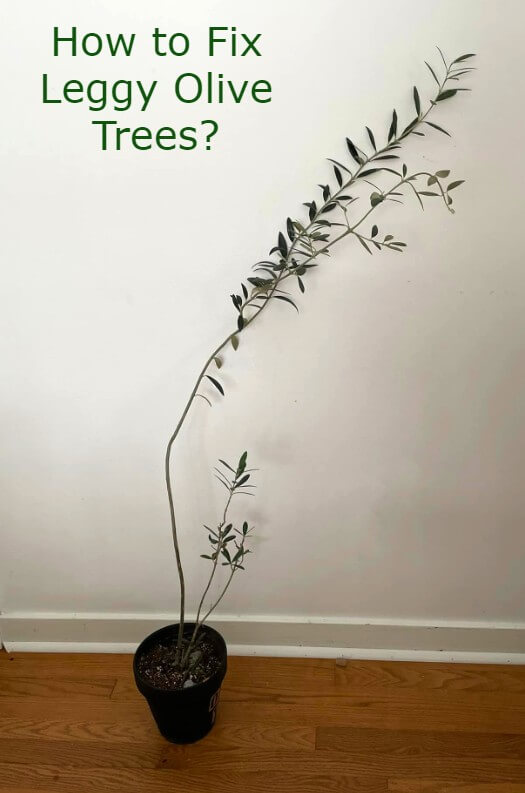
Solutions
With the right approach, pruning your potted olive trees can be a breeze! Here are some pointers to help you get started:
Timing and Tools
It’s best to prune olive trees after you’ve harvested your fruit for the year or early in the spring before spring growth. Intense sunlight can cause sunscald or bark rot on cut areas if you prune the tree in summer.
Use clean, sharp pruning shears or loppers to make clean, precise cuts that will heal quickly.
Technique
Focus on removing dead, damaged, or diseased branches first, followed by any crossing or rubbing branches to improve air circulation.
Sucker branches grow from the tree’s scion or rootstock and consume nutrition, weakening the olive tree. If you see a sucker branch grow from the bottom of the olive tree, prune it immediately, and your olive tree will regain its position.
Shaping
Aim to create a balanced, open canopy that allows sunlight to reach all parts of the tree, which will help promote healthy growth and fruit production.
Maintenance
Regularly check your potted olive tree for necessary touch-up pruning, especially during the growing season.
Relevant articles
Why olive tree is leggy and how to fix it
Searching for Premium Olive Oil?
Get OLIVIADA Olive Oil from Kalamata, GREECE!
2. Limited Root Space
When olive trees are grown in pots, their roots can’t stretch out as they would in the ground. If the pot is too small, it harms the expanding root system. An olive tree will quickly grow roots that hit the sides of the container and turn. The pot is full of circling roots within no time, and the olive tree becomes pot-bound.
This restriction can stunt growth, affect overall health, and even limit fruit production. But don’t worry; there are ways to ensure your tree has the space it needs to thrive.
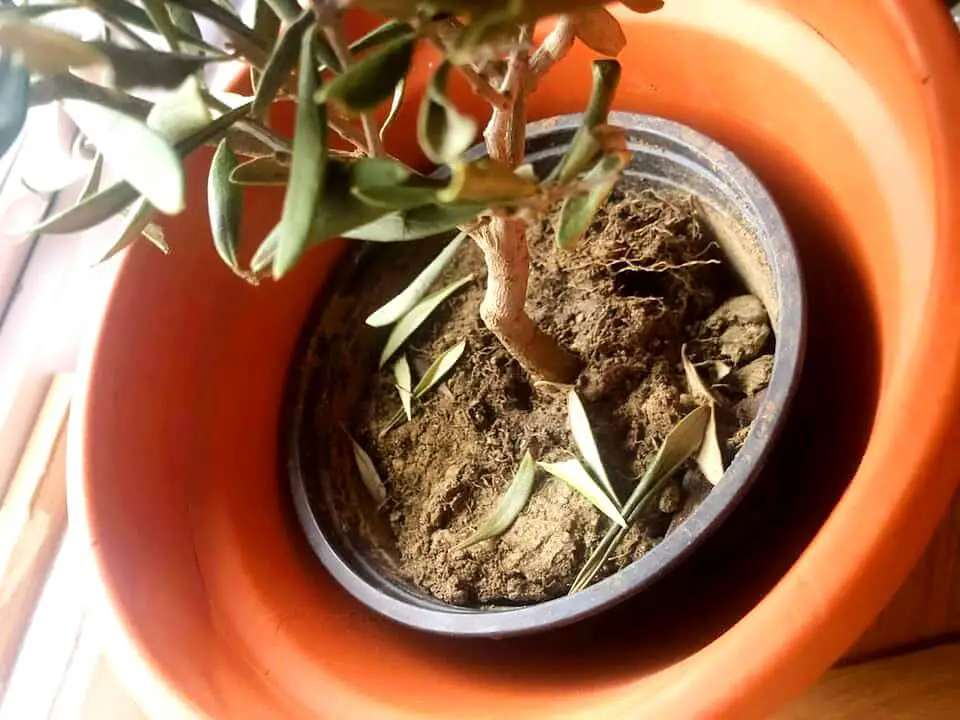
Symptoms
- Olive tree root system filled up the pot: The roots may completely occupy the container, leaving no room for growth.
- Roots get out from drainage holes or the surface: You might notice roots poking out from drainage holes or growing above the soil surface.
- Slow growth: Your tree may grow more slowly than expected or even become stunted.
- Yellowing or browning leaves: Limited root space can cause leaves to turn yellow or brown, especially near the bottom of the tree.
- Wilting: Your tree may still show signs of wilting or stress despite adequate watering.
- Reduced fruit production: Constricted roots can lead to fewer olives or smaller fruit.
- Leaf drop: You might notice roots poking from drainage holes or growing above the soil surface.
- Flower and olive fruit drop: Limited root space can cause flowers and olives to drop prematurely.
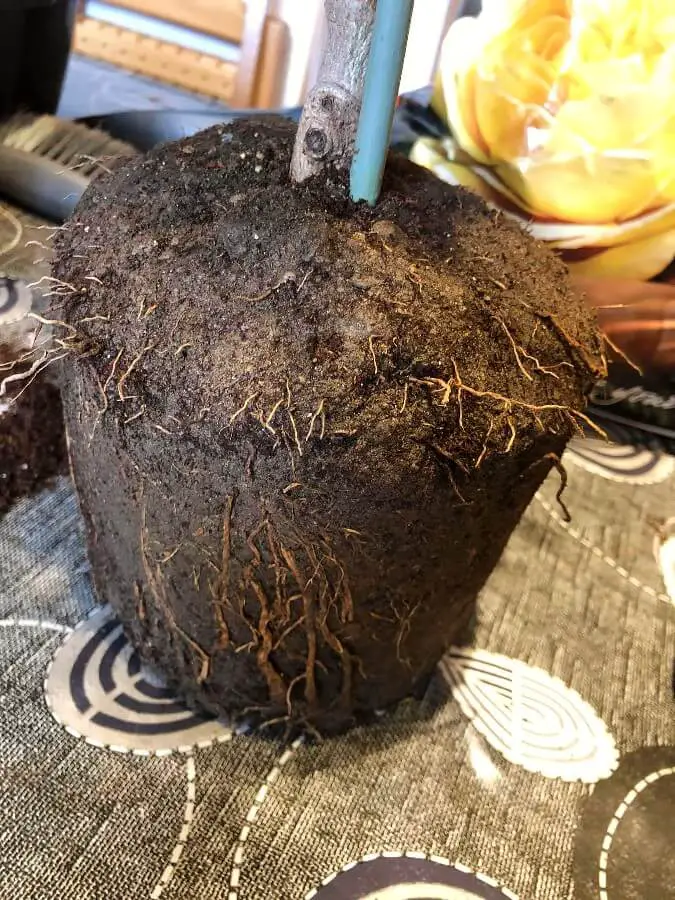
Solutions
Now that you know the symptoms, let’s explore some solutions to ensure your potted olive tree has the space it needs to thrive:
Choose the Right Pot
Choosing the right pot is essential for your olive tree’s root growth. Start with a container that’s large enough to accommodate your tree’s current root system, with room for growth. As your tree matures, keep an eye on its roots; if they start to circle the pot or become dense, it’s time to upgrade to a bigger container.
And here are several tips on choosing the right pot for your tree:
- Large enough to house the root ball of your olive tree, at least 25% bigger than the root ball of the tree
- Pick a much larger pot or container if you prefer to grow suitable and best companion plants for olive trees
- Do not put a small olive tree in a very large container; instead, size up the pot in stages
- Ensure that the pot has a sufficient amount of drainage holes.
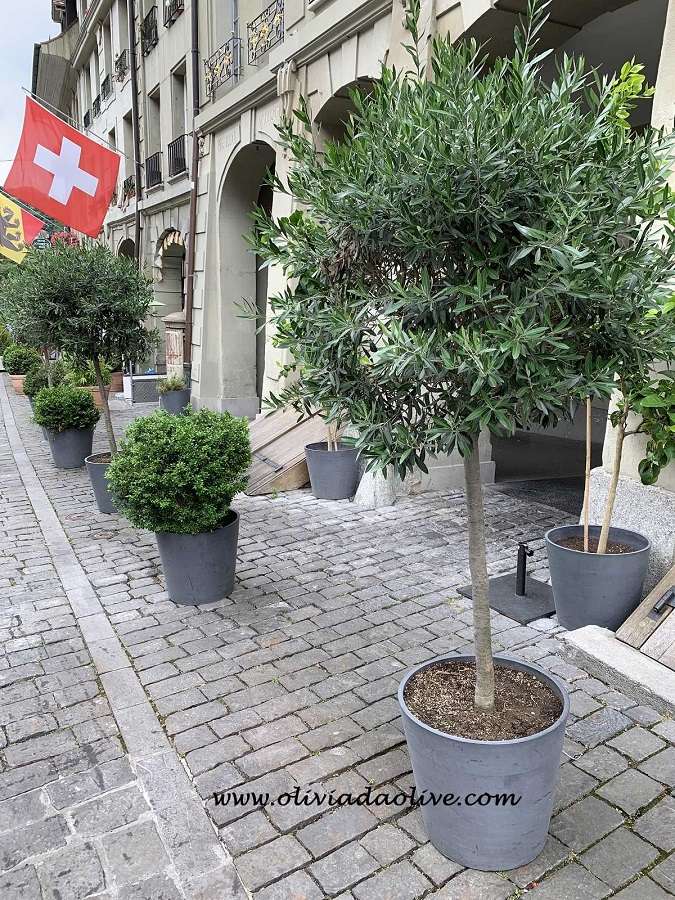
Repot Each Several Years
Several years after planting olive trees in pots, the trees circling roots will begin to strangle the trunk, ultimately causing harm to the olive tree. To avoid it, the olive trees need repotting at least every three to five years.
Also, when you notice your tree’s roots are filling the container, it’s time to give it a new home. Gently remove the tree from its current pot, tease out the roots, and place it in a larger container with fresh soil. Otherwise, if only one root has escaped from a drainage hole accidentally, trim off it without the urgent need to repot.
In olive tree transplanting, we have an in-depth guide on how and when is the best time to repot olive trees. After following these repotting steps, you can quickly eliminate one of the most common problems with olive trees in pots.
Root Pruning
If upgrading the pot size isn’t an option, root pruning can be a helpful alternative. Carefully remove the tree from its pot, trim back the outer layer of roots, and then replant it in the same container with fresh soil.
Ensure Proper Drainage
Ensure your pot has sufficient drainage holes to prevent waterlogged roots, which can exacerbate root space problems.
And don’t forget to monitor your potted olive tree roots to identify signs of overcrowding or stress.
Relevant articles
For more guidance on choosing pots based on material type and reviews, you can find them in our article: large pots for olive trees.
3. Poor Air Circulation
When your olive tree is stuck in a spot with inadequate air circulation, it’s like being in a stuffy, crowded room – definitely not a pleasant environment! Poor air circulation can lead to various problems for your potted olive tree, including increased susceptibility to pests and diseases, as well as reduced growth and productivity.
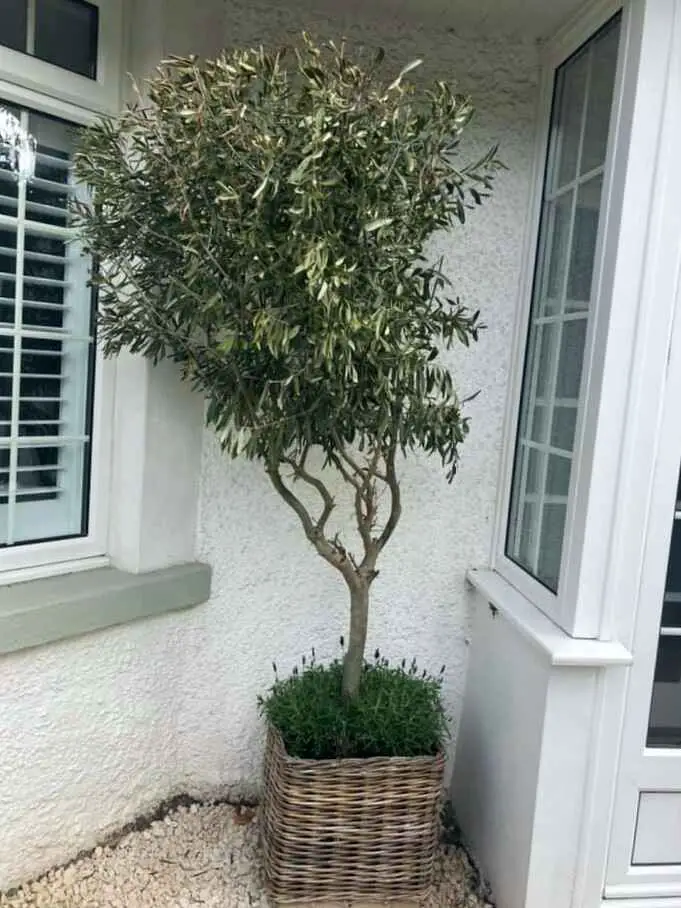
Symptoms
- Stunted growth or leggy appearance: The tree has slow growth or excessively long branches with sparse foliage.
- Increased susceptibility to pests and diseases: The tree becomes more prone to infestations and infections due to lack of air circulation.
- Weak or drooping branches: The branches cannot support their weight and begin to sag.
- Reduced fruit production and quality: The tree produces fewer olives and declines fruit quality.
Solutions
Prune Correctly
Prune your olive tree regularly to remove any overcrowded branches hindering airflow.
Location
Place your potted olive tree in a location where it has plenty of room to “breathe” and can enjoy a gentle breeze from time to time.
Make sure there is enough distance between your potted olive tree and other plants or objects that could obstruct air movement.
Use a Fan
If you’re growing your tree indoors, use a fan to help move the air around and prevent stagnant air from settling around your plant.
4. Bark Split or Holes in Trunk
Olive tree bark split is very common for olive trees; the older the olive tree gets, the more twisted and split trunk is. Also, deep holes may appear on a trunk.
It is caused by changes in growth conditions, e.g., dry weather followed by wet weather conditions, sunscald, age, and other reasons. If you see them, don’t worry, it doesn’t affect olive tree longevity if you take good care of your olive tree. In addition, pests or even physical damage may be a reason for bark split.
Symptoms
- Visible splits or cracks in the bark: Sudden or noticeable damage to the outer layer of the tree’s trunk.
- Holes or tunnels in the trunk: Evidence of pests burrowing into the tree, creating visible openings.
- Signs of pests, such as frass or sawdust around the tree’s base: Indicators of insect infestation, causing damage to the trunk and overall tree health.
- Weakening or dieback of branches: A decline in tree health, with branches losing strength or dying off.
- Poor overall tree health and vigor: The tree appears less robust and healthy, potentially due to damage or stress affecting the trunk.
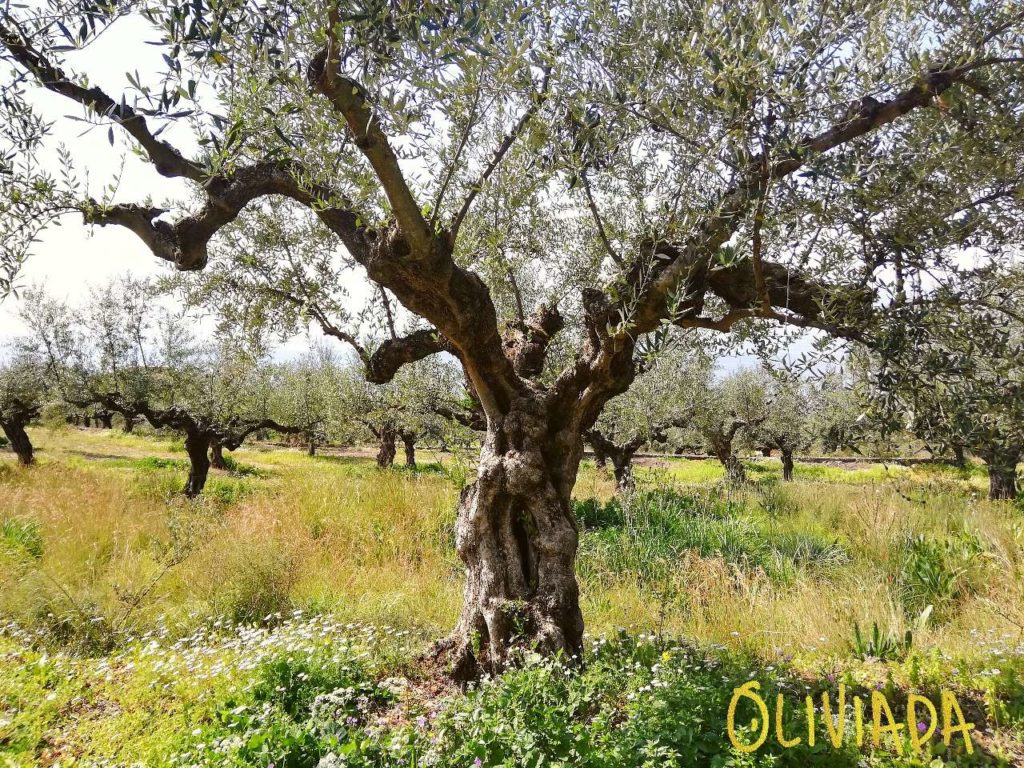
Solutions
Maintain Stable temperatures
Place your potted olive tree in an area with consistent temperatures to minimize the risk of bark splitting due to temperature fluctuations.
Pests Control
Monitor your tree for any signs of pest infestation. If you notice wood-boring insects or other pests, use appropriate insecticides or biological controls to manage the infestation.
Tree and Wound Care
Be cautious when moving your potted olive tree or using tools around it to prevent accidental damage to the bark.
If you spot a split or hole in the tree’s bark, keep the area clean and dry to minimize disease risk.
Regularly prune any dead or damaged branches to promote overall tree health and reduce the chances of further bark damage.
5. Moss on Olive Tree
Moss is a non-parasitic, non-vascular plant that may grow on olive tree stems, branches, and trunks and is often a worry to gardeners. While it may not directly harm your olive tree, it can indicate a problem with the tree’s growing conditions. Moss can also be unsightly and compete with your tree for nutrients and moisture.
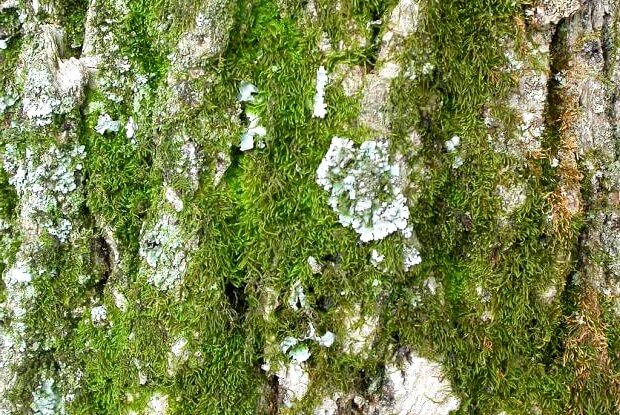
Moss Growth on Olive Tree Reasons
Moss is found in damp, humid places because it needs moisture for growth as well as reproduction. These are the reasons and conditions preferable for moss to grow on branches and twigs of olive trees:
- Your olive tree has been neglected. For instance, if the branches of your olive tree have become overcrowded and not so much sunlight reaches it.
- Humidity issue. Moss can also appear on a vigorous new olive tree in humid areas.
- Bad conditions. Moisture-loving mosses may colonize the side of olive tree trunks facing the prevailing wind and rain.
- Poor vigor. Olive trees in pots that are lacking in vigor, especially those which are already beginning to die.
Symptoms
- Green, fuzzy or velvety patches: You may notice green, fuzzy or velvety patches on the bark or branches of the olive tree. These patches are the moss growths themselves.
- Discoloration: Moss growth can cause the affected areas of the tree to appear discolored, often with a greenish hue.
Solutions
Even so, moss is not “deadly” harm to your olive tree; it still shows the tree lacks vigor and needs attention. For this reason, I have put together the solutions that help to control moss on your olive trees in pots and outside:
Improve Air Circulation
Prune any overgrown branches and foliage for better airflow around your tree. This will help keep the tree’s bark dry and discourage moss growth. As well as cut back overhanging vegetation.
Adjust Watering Habits
Be mindful of your watering routine, ensuring you’re not overwatering your olive tree. Allow the soil to dry out slightly between watering sessions to create a less hospitable environment for moss.
Increase Sunlight Exposure
If your potted olive tree is shaded area, consider moving it to a sunnier spot. Adequate sunlight will help deter moss growth and improve your tree’s overall health.
Manual Removal
Gently remove the moss by hand or with a soft brush, taking care not to damage the tree’s bark.
Use a Moss Control Product
If the problem persists, you can apply a moss control product specifically designed for use on trees. Be sure to follow the product’s instructions for the best results.
VIII. Grab Essentials to Treat Problems with Olive Trees in Pots
Here I attached popular products with great customer reviews available on Amazon:
- Sonkir 3-in-1 Moisture Meter – to control overwatering or underwatering issues
- TreeHelp Premium Fertilizer for Olive– for better growth and look
- Organic Neem Bliss 100% Pure Cold Pressed Neem Seed Oil – for pests and disease control
Last update on 2024-04-18 / Affiliate links / Images from Amazon Product Advertising API
IX. Troubleshooting Guide
Here’s an easy-to-read troubleshooting chart to help you identify and address specific issues with your potted olive trees:
| Issue | Symptoms | Cause(s) | Solution(s) |
|---|---|---|---|
| Underwatering | Soil pulling away from pot sides, wilted leaves, stunted growth | Insufficient water | Increase watering frequency, check drainage, use a moisture meter to determine soil moisture |
| Overwatering | Constantly moist soil, wet pot bottoms, yellow leaves, fungus gnats | Excessive water | Reduce watering frequency, improve drainage, repot in well-draining soil |
| Poor Drainage | Wet pot bottoms, yellow leaves, drooping leaves, fungus gnats | Clogged drainage holes, poorly draining soil | Clear drainage holes, repot in well-draining soil, ensure the pot has drainage holes |
| Nutrient Deficiencies | Drooping leaves, falling leaves | Lack of essential nutrients | Apply balanced, slow-release fertilizer, ensure proper soil pH, use appropriate potting mix |
| Overfertilization | Leaf drop, flower and fruit drop | Excessive fertilizer | Reduce fertilizer application, flush soil with water, use slow-release fertilizer |
| Pests | Visible pests, damaged leaves, poor growth | Infestation by insects or mites | Identify and treat pests using appropriate methods (chemical or biological control), maintain good hygiene and pruning practices |
| Diseases | Discolored leaves, wilting, dieback | Fungal, bacterial, or viral infections | Identify and treat disease, maintain good hygiene and pruning practices, choose disease-resistant varieties |
| Soil pH | Falling leaves, flower and fruit drop | Improper soil pH | Test and adjust soil pH, use appropriate potting mix |
| Transition Stress | Wilted or drooping leaves, yellowing leaves, leaf drop | Sudden changes in environment (light, temperature, humidity) | Gradually acclimate the tree to new conditions, avoid extreme changes |
| Sunburn | Yellowing or browning leaves, crispy dry leaves, bark cracking | Excessive direct sunlight | Provide partial shade during peak sun hours, gradually acclimate the tree to increased sun exposure |
| Temperature Extremes | Wilted leaves, yellowing leaves, leaf drop, flower and fruit drop | Exposure to extremely hot or cold temperatures | Provide protection from extreme temperatures (move indoors or provide insulation), maintain consistent temperature conditions |
| Low Humidity | Crispy or curled leaves, browning leaf edges, leaf drop | Insufficient humidity | Increase humidity using a humidifier, misting, or a pebble tray, group plants together to create a microclimate |
| Lack of Pruning | Overcrowded branches, reduced air circulation, leggy growth | Insufficient pruning | Prune regularly to maintain shape, remove dead or diseased branches, promote air circulation |
| Bark Split or Holes in Trunk | Visible splits or holes, possible insect infestation | Physical damage, insect activity, environmental stress | Inspect and treat for pests if necessary, protect the tree from further damage, avoid drastic changes in environmental conditions |
| Moss on Olive Trees | Green moss growing on branches or trunk | High humidity, poor air circulation | Improve air circulation, prune to increase sunlight penetration, remove moss with a soft brush |
X. Frequently Asked Questions
How often should I water my potted olive tree?
The frequency of watering depends on factors like tree size, pot size, and temperature. Generally, you should water when the top 1-2 inches of soil feels dry. Make sure not to overwater or underwater your tree.
What’s the best type of soil for my potted olive tree?
Olive trees thrive in well-draining, slightly acidic to neutral soil (pH 6-8). A mix of potting soil, perlite or pumice, and compost works well for potted olive trees.
How do I know if my olive tree is getting enough sunlight?
Olive trees need at least 6-8 hours of direct sunlight daily. If your tree isn’t getting enough sun, it may show signs like yellowing leaves, weak growth, or reduced fruit production.
How can I prevent pests and diseases in my potted olive tree?
Keep your tree healthy by providing proper care, including adequate water, sunlight, and nutrients. Regularly inspect your tree for signs of pests or diseases, and treat them promptly. Prune your tree to improve air circulation and reduce the risk of infestations.
When and how should I prune my potted olive tree?
Prune your olive tree in late winter or early spring, before new growth begins. Remove dead or damaged branches, thin out overcrowded areas, and shape the tree to encourage healthy growth.
How do I protect my potted olive tree from temperature extremes?
In hot weather, provide shade during the hottest part of the day and ensure adequate water. In cold weather, move the pot to a sheltered location or wrap the pot and tree in insulation to protect the roots from freezing.
Can I grow an olive tree indoors?
While it’s possible to grow an olive tree indoors, it requires a bright, sunny spot with at least 6 hours of direct sunlight daily, and proper care to ensure it remains healthy and productive.
XI. Final Thoughts
With growing olive trees in pots, there may come some problems. However, knowing the symptoms of the tree “illness” and knowing how to treat them, you can anticipate any problems that may arise while enjoying the olive trees in pots in your surroundings.
With the knowledge I’ve shared and the practical tips provided, you can handle these challenges and enjoy a thriving potted olive tree. Remember to pay attention to your tree’s specific needs and adjust your care routine accordingly. Keep an eye out for any symptoms of these problems and take timely action to address them.
If you are thinking of buying an olive tree for the first time, I have a helpful guide that will make buying an olive tree easier. And once you have purchased the olive tree, I have some helpful guides to grow your olive tree successfully. Below are a few of my popular articles.
- What to Look for When Buying an Olive Tree?
- How to Grow Olive Trees in Pots Indoors?
- How to Care for Olive Trees in Pots?
As you continue your olive tree-growing journey, always feel free to return to this article as a handy reference. I hope this post helps learn the problems with olive trees in pots. Thus my solutions will help you successfully grow your first olive tree in your garden, home, or patio. Happy growing!
Read Next
HOW TO REVIVE OLIVE TREE & BRING IT BACK TO LIFE
Learn More
- Olive Tree Not Growing or Producing Leaves? Try this
- Best Soil for Olive Trees
- Best Fertilizer for Olive Trees
- How to Prune Olive Trees in Pots?
Hi, I’m Vangelis Kleftogiannis, the founder of Oliviada and an established olive oil expert from Kalamata, Greece. My expertise isn’t just in producing quality Extra Virgin Olive Oil, but also in the cultivation and care of olive trees themselves. I am deeply committed to sharing my knowledge and know-how, helping others understand the intricacies of olive tree growing and the creation of quality olive oil.
Are You Looking to Buy an Olive Tree?
If you are looking to add more potted trees or other plants to your orchard, or if you like to replace a neglected olive tree, the best places to get them are your local nursery or an online nursery.
One of the most reliable and the world's largest online nurseries is Fast Growing Trees. They deliver fast, neat, and healthy plants backed with a 30-day guarantee.






Thank you so much for the thorough guidelines! I just acquired an Arbequina Olive Tree in a pot for indoor use. Unfortunately, after a week it’s starting to drop leaves every day. Most of them are curled and dry Some a green. The bottom soil is damp but the top portion is dry to slightly damp. I added a 21-6-5 fertilizer when it first arrived. So Im not sure if it has too much Nitrogen. Our living room gets plenty of light but it’s not maximum direct sun light. I’m hoping I can save this tree!
Hi Jenine, so sorry to hear about your new olive tree indoors. I believe the olive tree started to drop leaves due to the relocation stress. When you buy a potted tree and bring it home, it’s leaves start falling within a week or so, and keep falling, mostly it’s because the light has changed dramatically. Imagine, firstly the olive tree was growing in a nice greenhouse, then it went to the store where everything got dark, then it went to your home, where things got darker still comparing greenhouse or outdoor conditions. As a result, the olive tree’s first response is to drop leaves and put out new ones that are better accommodated to the lower light.
Don’t fertilize anymore as it may be too much stress for a tree in a new home. As well, try to get a moisture meter to learn when the watering is required. (p.s. i added links to other articles which may be helpful for you to investigate the potted olive tree problem)
Hi Vangelis!
I have an olive tree in a pot that I grow outdoors in the state of Oregon. Your information was VERY helpful, I’ll look to begin to incorporate what you’ve written. I Googled “olive tree yellow leaves” and your information came up. Thank you so much, I absolutely fell in LOVE with these ancient trees when I was in Israel, and I’m so pleased that I now know what to do to keep it healthy and beautiful! Blessings to both you and Olivada!!?
Sincerely, Julie Sunderland
Dear Julie Sunderland,
Thank you for your kind words! I am glad you have join olive tree lovers community and growing your own olive tree in pot :)
In terms of yellow olive tree leaves it may be caused by over watering. So please try to measure moisture with moisture meters first. As well, i have other 2 great articles on how to revive olive trees and how to grow olive trees in pots indoors. They both have lots of valuable knowledge inside. Check it out and let me know how it goes!
I have a olive tree in a container for many years which I have fed from spring , it looks healthy and flowers but does not produce olives after flowering, what can I do.
Hi David! Has your olive tree produced olive fruits earlier years? the truth is some olive trees are flowering but they never produce the fruits because they are fruitless. This type of olive trees are chosen by olive growers if they don’t want a tree to bear fruits, example if the tree grows close to the path and the owner wants to keep the area clean without fallen fruits.
Thank you so much for your advice and guidance and realised what I have done right or wrong. So pleased to have found this page.
I have two questions about my Olive tree in a pot:
– the tree has been repotted in a larger pot (probably too large after reading your article). It is spindly, thin long branches. Should I shorthen the branches to make it thicken out?
– can I plant Mexican fleabane in the pot around the tree? I’ve notice that Olive trees are in bare pots!
Thank you
Thank you for this! I relocated my outside container plants inside in a bright sunny corner and they are dropping green leaves. But from the comments above, I’m going to credit this to relocation? Otherwise they appear very healthy, with no yellow leaves. I water twice a week, putting them in a place where I can water and allow to drain completely. Am I on the right track?
Hi Erin, I am glad you found my article helpful :) don’t worry about the larger pot – it is always much better than to repot into a too-small pot. Just monitor the soil moisture and make sure your olive tree is not starving.
– Definitely, I recommend to prune potted olive tree once per year and cut off thin long branches as to strengthen the core branches. You can find short 7 step guidelines on how to prune olive trees in pots here.
– As for Mexican fleabane, this plant loves the Medittarean climate the same as an olive tree. So in terms of maintenance and care these 2 plants have similar needs: enough water and lots of sun. And they can live together easily. By the way, since you mentioned you repotted an olive tree into a larger pot, you can plant Mexican fleabane in the edge of the pot. Just regulate the water needs and if one of the plants starts showing “unhappy” signs if any, re-pot them separately. But overall, it should be fine! Happy growing and enjoy these beautiful plants!
Dear Amy, yes, your olive tree may be stressed due to changes in the environment and it needs time to adapt to a new indoor climate. However don’t overwater potted olive tree, twice per week sounds too much! For the better estimate, check the soil moisture and nutrients as per my guidance in the article on how to grow olive trees indoors.
Overall, olive trees have a tendency to live in various conditions for many years, so it should boost soon in a new place and you can admire a Meditterean spirit in your home :)
I have had my olive plant for two years, it is in a large pot. I put it outside in the summer and in my unheated garage in the winter. My question is when do these plants start to get flowers and then olives? I have a lot of leaves and the branches reach up tp the sky. I am thinking that maybe I need to go to a larger pot.
Hi Tom, you are taking very good care of your olive tree, just make sure the tree gets enough sunlight in the garage. If not enough, get grow lights as substitute. in terms of flowering and bringing fruits, normally olive trees must reach about 3 to 5 years old for first fruiting, but it varies depending on the cultivar. As well, how well do you care of your tree and whether the tree came from seed or cuttings.
You may find interesting facts in our articles: on how to care for olive trees and steps on moving olive trees indoors for winter.
Wow what a wealth of knowledge! I have had my olive tree for a few years now and have been really pleased with its growth and this year although living in the UK with changeable weather conditions it actually had 4 olives. However, I have noticed that it is looking spindly and on moving the pot slightly seen roots coming from the bottom. I have searching the internet for information on what to do and voila found this! Thank you, I feel more confident in what i have to do now.
Hi Sue, thanks for your nice words – it means a lot to us! Definitely, repot your olive tree since the pot is becoming too small for the rootball of your tree. Check out our guidelines on how to re-pot an olive tree and more valuable information. Happy growing these beautiful trees!
Hi there! Thank you sooo much for the wealth of information you offer on your site!! I’m learning how to raise my three new Arbequina babies!!
I need some help dealing with an issue that came up. I wish i could send you a couple images… The leaves got covered with this grayish scale, and i don’t know what to do about it. I also found a little round but/mite on them. If you have a chance, please help! ?
Hi Andrea! Thank you for your kind words! I have just created a Facebook group – community for olive tree growers to share pictures and ask questions. Please join it here.
Indeed, the scale is one of the most common problems with olive trees. It causes leaves to look unhealthy and become stressed.
The first thing you should do is clean your olive tree. Use a garden hose to rinse the honeydew off the tree. Allow a tree to dry.
Next, take a cotton ball, soak it with rubbing alcohol, and gently wipe away the scale.
Last but not least, use an insecticidal soap or neem oil and thoroughly spray the entire olive tree. It is important to spray all parts of the olive tree to suffocate any scale insects and eggs that you may have missed.
Keep an eye on your olive tree constantly and if needed, repeat the above steps up until you get rid of the scale.
With a bit of care and love, your trees will come back stronger and healthier! Happy growing! :)
Hi
Thank you for your articles, they are very helpful. You mentioned favorably self-watering devices. Do they provide adequate moisture level? I am thinking to use a self-watering device in which the water evaporates from a container placed inside the pot and moistens the soil through a perforated lid. It is used together with self-watering soil mix, which has Canadian sphagnum peat moss, peat humus, perlite, limestone and gypsum. Will olive tree grow well in this soil? Thank you!
Hi KG, olive trees in pots require frequent watering and self-watering devices are one of the solutions for people who forget to water their plants when they fully dry out. Even so, if you decide to use a self-watering device you must ensure that soil is not too moist and stay on a dry side since olive roots won’t stand to be constantly humid. The soil mix you referring to sounds like stony, well-draining soil and will do well with a bit of extra care.
Really love your article. I bought a small olive tree and it took off in its container. Again it was small and in NJ, I realize Im not going to get olive oil or probably even olives. Anyway, I kept it on the ground in the garden with other potted plants and a rabbit chewed through the stalk and left the plant about 4 inches tall with 4 healthy leaves. I continue to maintain the plant hoping for a come back but its been a good month since that happened and so far no new growth. My question is, should I expect to get suckers in between the leaves? Or once olive trees are bruised this deep they just dont recover? Anyway, hope that makes sense because Im holding out hope for the little guy.
Hi Tom, sorry to hear about the damage caused to your tree by a rabbit. As long as roots and trunk are healthy, the olive tree will recover – however, be patient – it may take many months until new buds and suckers appear. Try to fertilize to boost growth and water regularly. Even if you cut back the olive tree to the trunk it would recover, just no one knows how soon. it all about the overall olive tree health and environmental conditions: it needs full-day sunlight, nutritious soil, and water regularly. Fingers crossed you will see new growth soon!
This is a very useful site, thank you.
I don’t think that my olive tree’s problem has been mentioned. A healthy tree, about five years’ old, it is watered and fertilised. A new crop of hundreds of olives appears in early June, lasts two days and then they all wizen on the branches. I would be very grateful to know how to tackle this issue.
Hi Pippa, wrinkled or wizen olives are associated with water stress. This often happens when olive trees suffer weather conditions when persistent drought and high temperatures occur simultaneously. If you had a head wave recently or weather abnormalities, you should water your potted olive tree more often than regularly, especially during the summer heat. Also, observe your olive tree carefully if you see any signs of a fungus disease that affect olive fruits.
I have a problem that hasn’t been mentioned. The leaves on one of my small trees has pinpoint size brown spots on it. This started after I brought both of them home. It seems healthy otherwise. I’ve sprayed it several times with an insecticide soap spray. It doesn’t seem to help. This has been going on for almost two years. I noticed a few of the leaves on my other olive tree now has a few leaves with this on them. Is there a solution for this problem?
Also I would like to make one of the trees into a bonsai, could you tell me the best way to do that?
I live in NE Georgia
Thank you for your time and very informative articles.
Rose.
Hi Rose, hope you are doing well. Brown spots may be caused by fungal infections or bacteria. You should try to apply fungicide instead of insecticide soap. Before buying a fungicide consult at your local garden center, they may give you amazing advice based on their experience and local know-how. However, if it is not spreading on a tree and appearing on new olive leaves, you should not worry at all – probably it was just a one-off problem (related bacteria or fungi) that is gone now and left brown spots as consequence.
In terms of making olive trees into bonsai, I have another detailed article you can look into (you can search by “make olive tree into bonsai” on my website) and let me know if you have any further questions. Take care and regards, Vangelis
My friends puppy has eaten the foliage off and snapped the tree halfway down . Will it survive and should we prune it further?
Hi Norma, only prune dead or damaged branches. It will survive and eventually will show new branches.
Hi. Love your Olive articles, so much helpful information.
I’m in UK and last year, September, I
purchased a mature, 3-5 year old Europen Olive tree in a medium container. The company re-potted it at my home in a sizeable terracotta urn.
Given this is the UK, I looked after it carefully all winter and wrapped it, and the pot, up well against the frosts. I watered it from time to time.
I unwrapped it a couple of weeks ago, and the leaves look fine BUT, I’m noticing roots on the surface of the soil ??
I contacted the seller, who didnt seem concerned and told me to just feed it.
However from everything I’ve read, roots showing up is a concern.
I have today given it specialist olive fertilizer and top dressed it, but would live to have your opinion on this issue. Many thanks.
Hi Julia, I am very happy you find my articles helpful! In terms of surface rooting, it may happen due to a lack of oxygen when your tree was wrapped up over winter. There are couple of things you can do about it: you can add topsoil to the exposed root area if have space in the container or you can repot the tree in the same container in spring. I do not advise trying to prune or cut away these roots as it will likely damage the olive tree itself.
Hi,
Thank you for your thorough and excellent advice. I have two young olive trees in pots outdoors, here in France. One of them is showing signs of a lack of water through winter, and has dropped a lot of yellow leaves. Since I realised it needed water it is beginning to recover and has some new spring growth.
My bigger problem now is with my other tree, which stayed healthy all winter but which right now is also beginning to lose leaves. It has some spots on the branches whick look like white foam or spittle. I think it must be an insect but I can’t see any. Can you please advise? Thank you.
Hi Katherine, I am glad you find my articles useful! Try to use insecticidal soap or use homemade soapy water in order to wash away white stuff on olive branches. If your olive tree is attached by insects it should work. Repeat each week for a month. If they aren’t insects, it may be fungus where neem oil may help. As for watering issues, once you set up the correct watering routine for your olive tree, it will thrive.
My daughter bought me 3 one gallon olive trees from a big box store garden center. Year two and year three they bore fruit. I transplanted each to 5 gallon on year two. They get great sun and are in good soil. Year two and year three, they bore good fruit, but only on holf of the plant. The tree splits into a Y about 6” from the graft. All three plants do this, all three different types of olives. Any ideas?
Hi Jim, your olive trees are very young, they have just started to bear olives. Normally, olive trees have full production in 7 to 10 years after planting depending on olive cultivar. Then mature olive trees produce full production every second year, so keep growing new shoots and gradually increase olive production. Another thing, olive trees do not bear fruits on the same branches again (for this reason, normally branches that produced fruits are cut off after collecting the harvest). Also, check out my other article about why olive tree not producing.
Very interesting article, thanks.
My tree is in a large pot (possibly too large) I purchased it last year and it has been on my patio since then, through the winter and all summer, it has definitely grown and looks healthy but there is lots of growth at the top of the tree. Should I prune these branches in the autumn or leave them. Thanks for any advice.
Hello Joyce,
Thanks for your message. Your olive tree, flourishing and sprouting with vigor at the top, seems to be loving its new environment. This top growth, while a sign of health, might be a tad eager. Left unchecked, it could overshadow the lower branches, making the tree a little top-heavy and possibly affecting its overall balance.
Now, the question of pruning often comes up in such situations. Pruning not only helps in maintaining a balanced structure but also ensures good airflow and sunlight penetration, which are crucial for your tree’s overall health. As you’re seeing a lot of activity at the top, you might want to consider addressing it to ensure a balanced and harmonious growth pattern.
If you’re wondering about the specifics of pruning, especially for olive trees in pots, I’d recommend checking out this detailed guide on how to prune olive trees in pots. It’ll provide you with all the information you need to make sure your tree remains happy and healthy.
As for the pot size, while it’s wonderful that your tree has space to grow, be mindful of watering. Large pots can sometimes retain more moisture than the tree needs, especially if there’s more soil than roots. Ensuring proper drainage and being attentive to the tree’s water requirements will go a long way in keeping it thriving.
Wishing you and your olive tree all the best! Happy gardening!